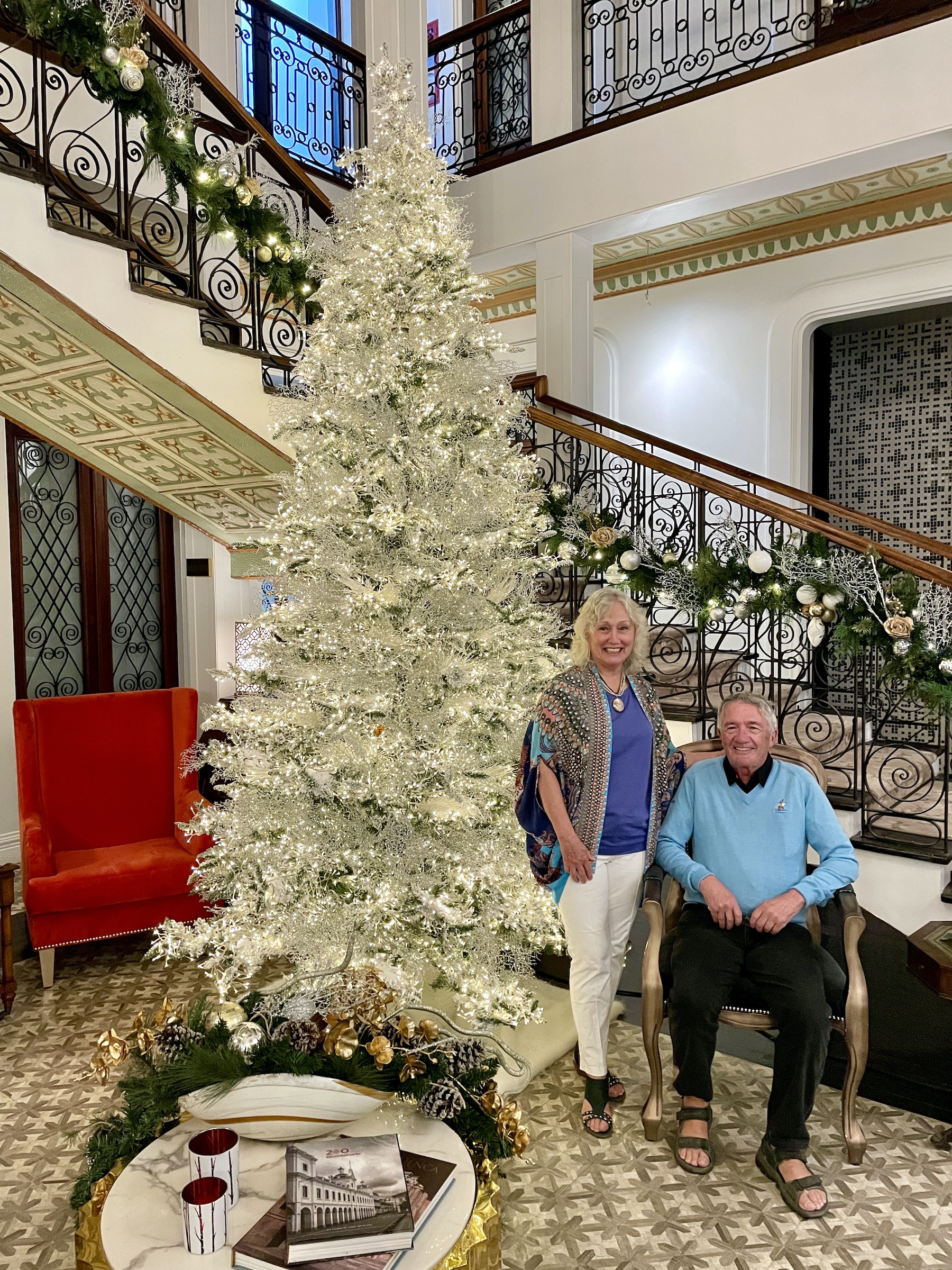Cuenca – Ecuador’s Fantastic Third City
When most people think of Ecuadorean cities, Quito and Guayaquil usually come to mind, but not the country’s third largest city, Cuenca. I confess that even though I am supposed to be a geography buff it was not on my radar screen until I started planning our itinerary for after we had concluded the Adventures Abroad portion of our trip. As mentioned in the last post, I knew that Adventures Abroad did have a tour that included the Avenue of the Volcanoes and three nights in Cuenca, but it did not include the Galapagos which is why we did not take it. Instead Alison and I were largely going to follow the same itinerary that AA did, but with our own private guide.
In the last post I introduced Wilson Rosales from South Land Touring who was our guide and driver for this portion of the Ecuador trip. Although I included our trips to Cotopaxi and Chimborazo in one post, they did not take place on the same day. We went to Chimborazo after spending the night in Banos and from there headed for Cuenca.
There was supposed to be one more stop on the way, one that I had been looking forward to for a long time – a train ride through the Devil’s Nose portion of the Ecuador rail system. It is one of the great train rides in Latin America. But alas, Covid has completely shut down the Ecuadorean rail system and it still has not reopened. So the best I could do was look down at it from above as we passed by it on the way to Cuenca.
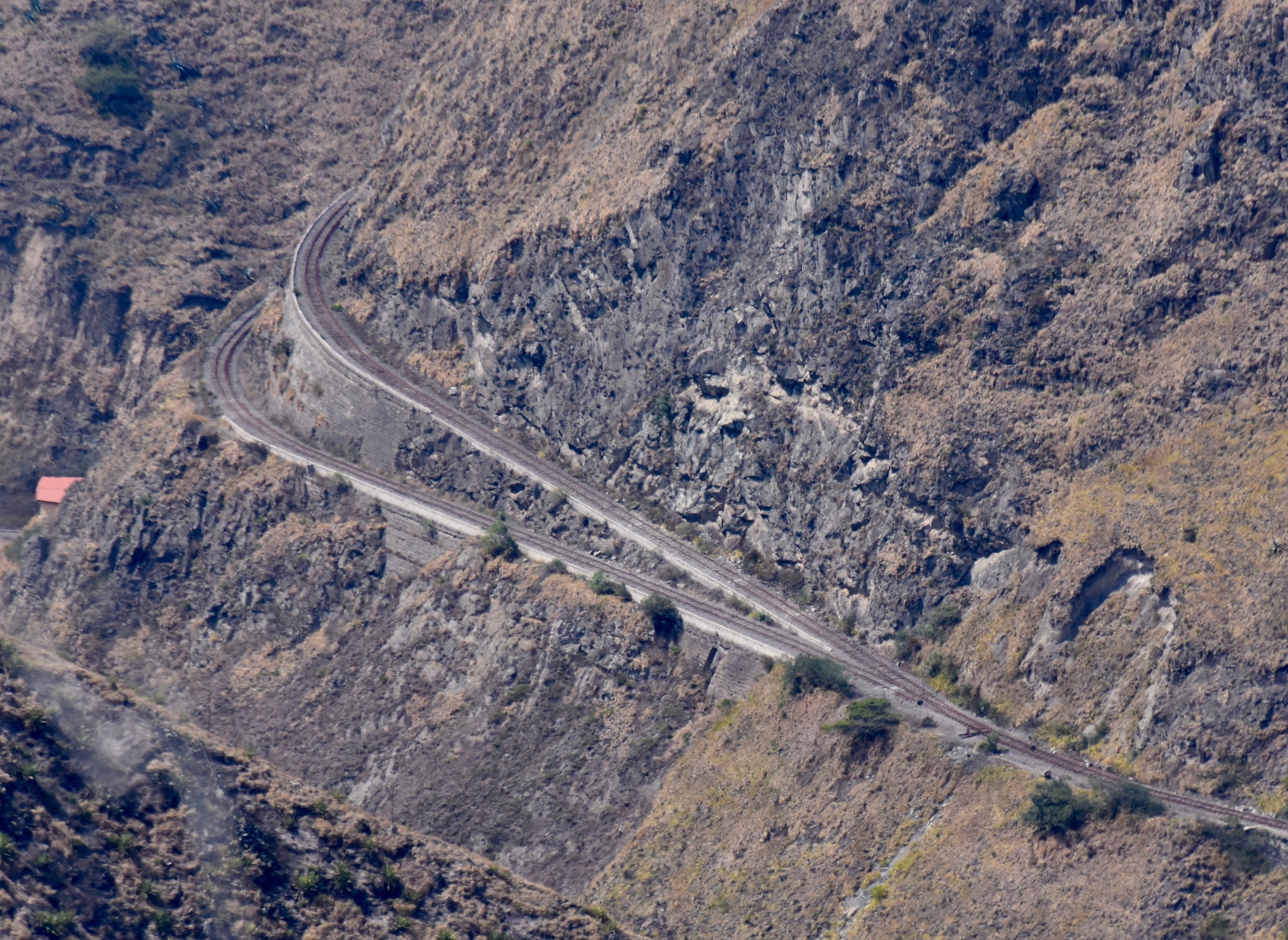
History of Cuenca

Cuenca is located on a high Ecuadorean plain that has seen human habitation for at least 10,000 years. Archaeological records show many different peoples occupying this southern part of Ecuador over the ensuing millennia until one group, the Canari, established a settlement on the site of present day Cuenca around 500 AD. The Canaris were quite advanced in their agricultural techniques and their knowledge of astronomy. However, this did not help them stop the relentless drive north of the Incas who, after numerous attempts, finally conquered the Canari city and renamed it Tomebamba in around 1470. The Incas then set about building an entirely new and grander city on the same site which they likened to a second Cuzco, the Inca capital in present day Peru.
The Incas did not have a lot of time to enjoy their newly acquired territory as the Spanish conquistadors had arrived and also pushed north, always looking for the fable ‘city of gold’ they had heard rumours of since first landing on the Peruvian coast in 1524. By the time they arrived at Tomebamba a few years later all they found were ruins. As they would do at Quito, the Incas destroyed their city rather than see it sacked by the conquistadors.
In 1557 Gil Ramirez Davalos formally founded the city of Cuenca which took its name from the Spanish city of the same name, well after Quito and Guayaquil which were major settlements by then. The city was laid out in a grid pattern along both sides of the Tomebamba River under strict guidelines established for new settlements by King Charles V of Spain. Fortunately for present day Cuenca, not much in the way of natural or man made disasters seems to have blighted the city over the centuries since its founding. The result is one of the best preserved colonial inner cores in Latin America. In 1999 Cuenca was inscribed as a UNESCO World Heritage Site with this description:
Santa Ana de los Ríos de Cuenca is set in a valley surrounded by the Andean mountains in the south of Ecuador. This inland colonial town (entroterra ), now the country’s third city, was founded in 1557 on the rigorous planning guidelines issued 30 years earlier by the Spanish king Charles V. Cuenca still observes the formal orthogonal town plan that it has respected for 400 years. One of the region’s agricultural and administrative centres, it has been a melting pot for local and immigrant populations. Cuenca’s architecture, much of which dates from the 18th century, was ‘modernized’ in the economic prosperity of the 19th century as the city became a major exporter of quinine, straw hats and other products.
As an aside, Cuenca’s namesake city in Spain is also a UNESCO World Heritage Site.
While the historic aspect of Cuenca attracts many tourists, its excellent climate and reasonable cost of living without the crime and poverty of parts of Quito and Guayaquil, has made it popular landing spot for both American and Canadian expats.
Itza Hotel
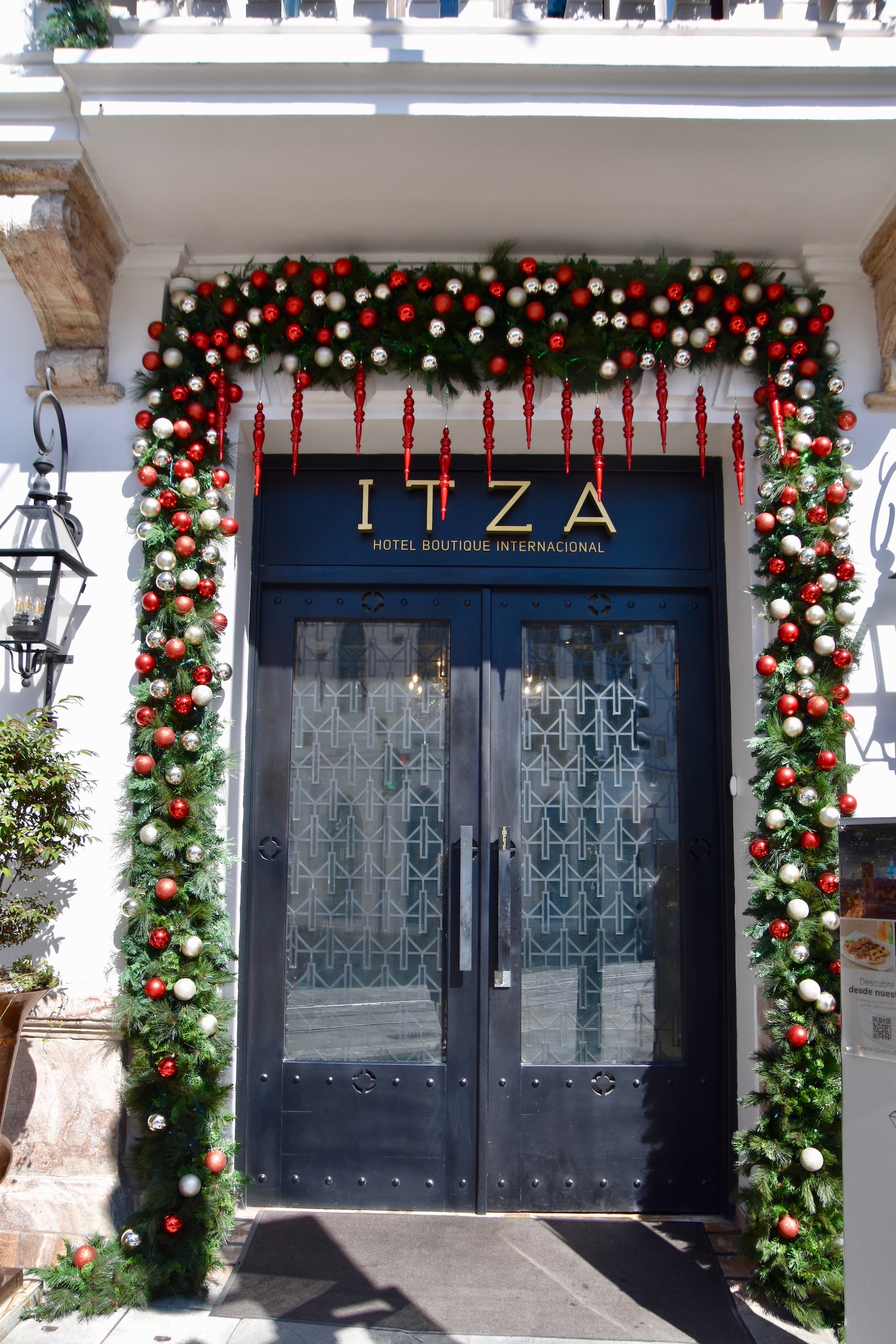
We arrived in Cuenca around check in time at our hotel, the Itza which is a newly opened boutique hotel in the heart of the historic city core. If you take one thing away from this post it should be to stay at this great hotel while in Cuenca. Although built as a hotel in the 1930s it was closed and languishing until Maritza Vélez, an Ecuadorean who spent most of her life in Canada, returned home and had it lovingly restored.
The rooms are large and bright with high ceilings and chandeliers.
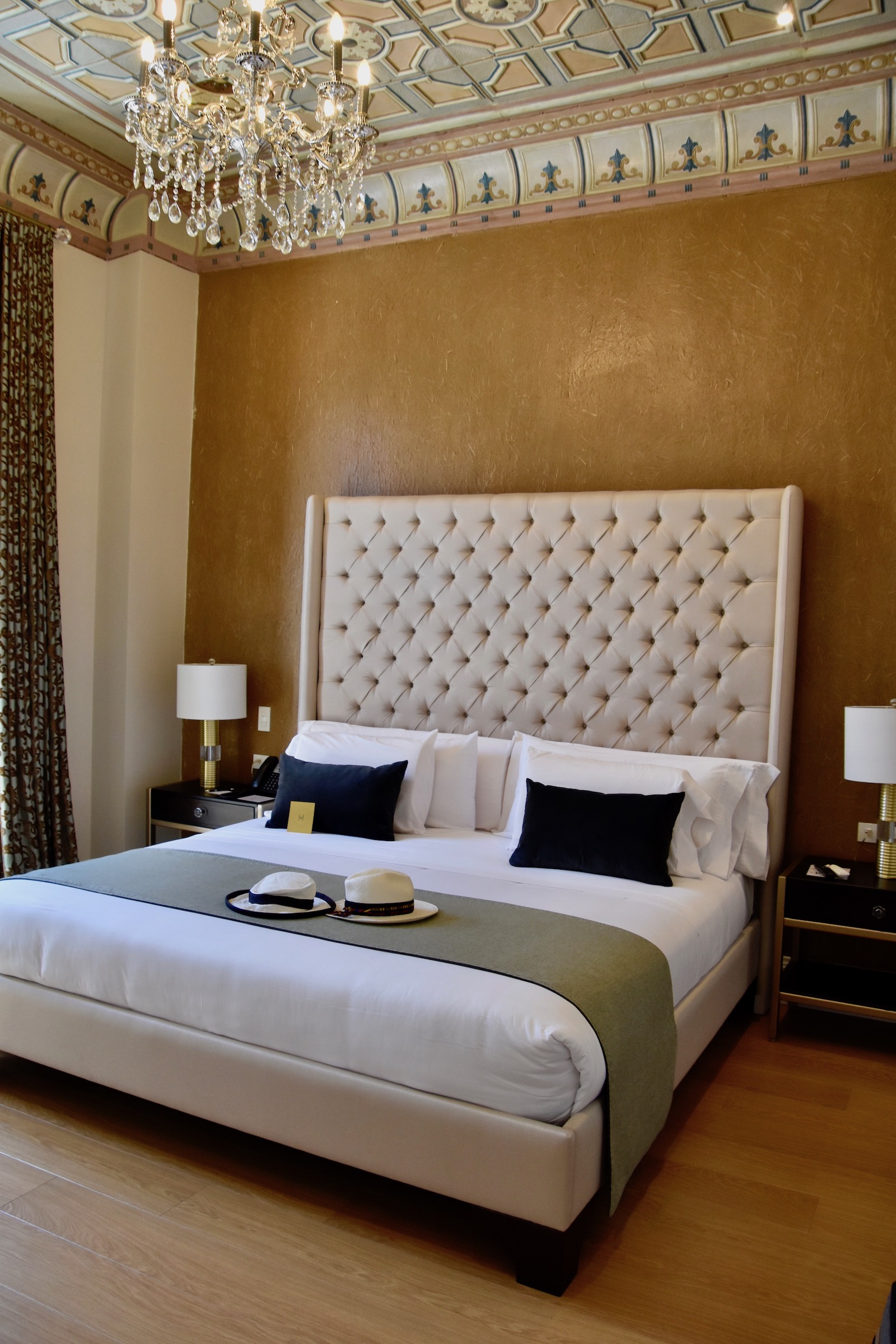
The rooms have balconies that let you watch life on the streets of the city unfold below you.
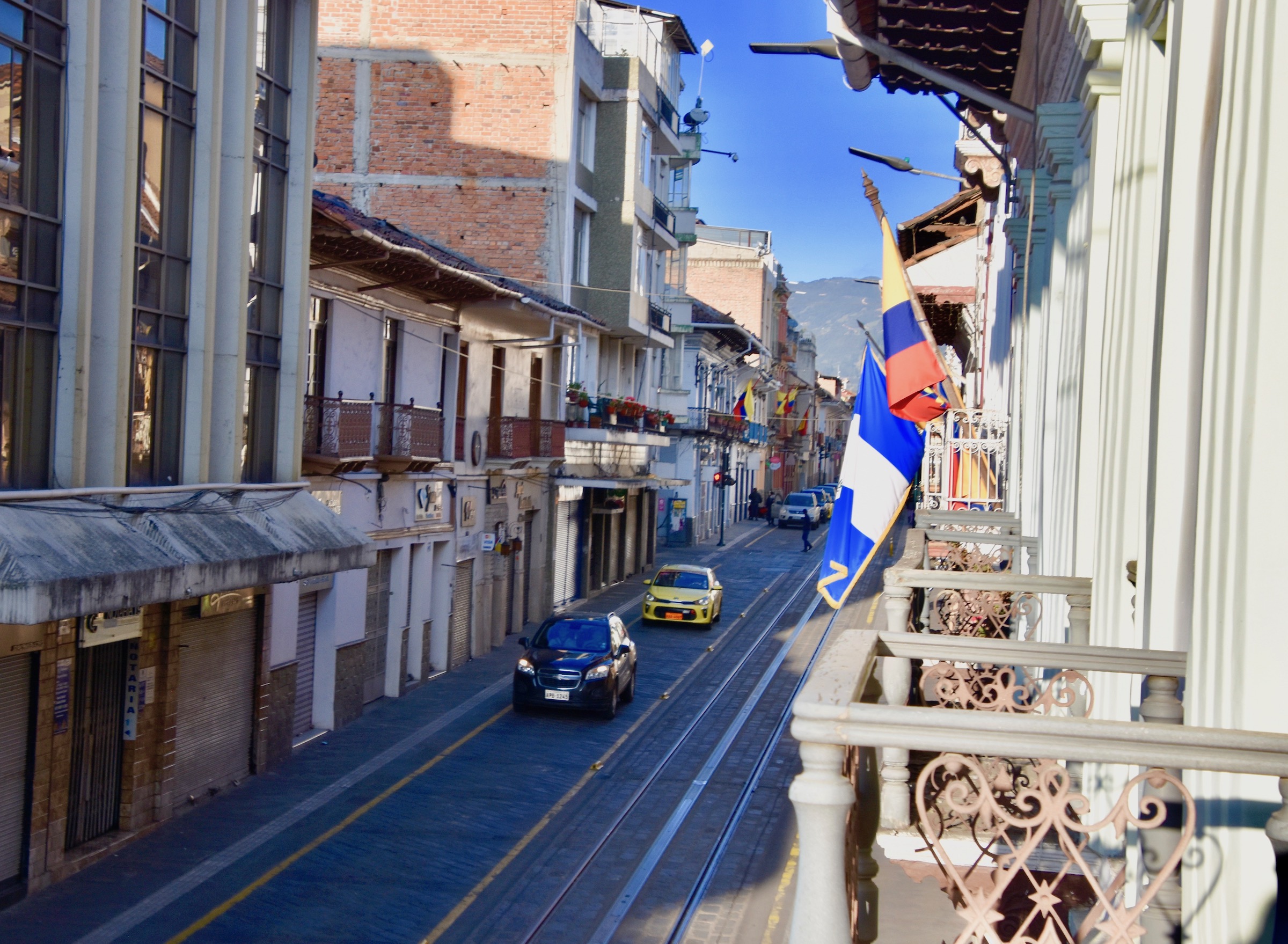
The restaurant is excellent as well, but the real clincher for me was the rooftop bar with these magnificent views. At night the cathedral is lit up like three beacons and really a site to see.
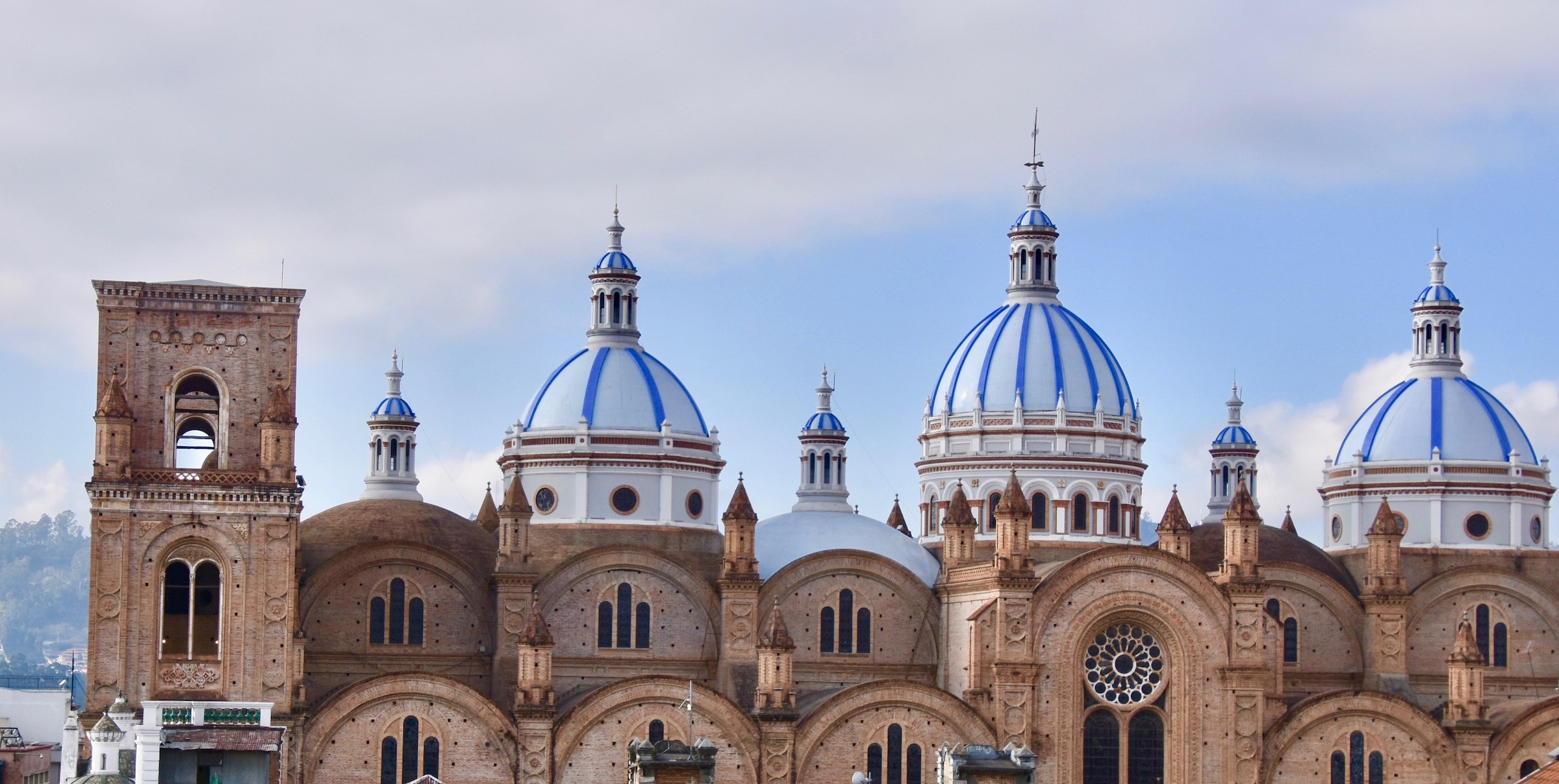
On the other side is this view of the Church of Santo Domingo with the mountains in the background.
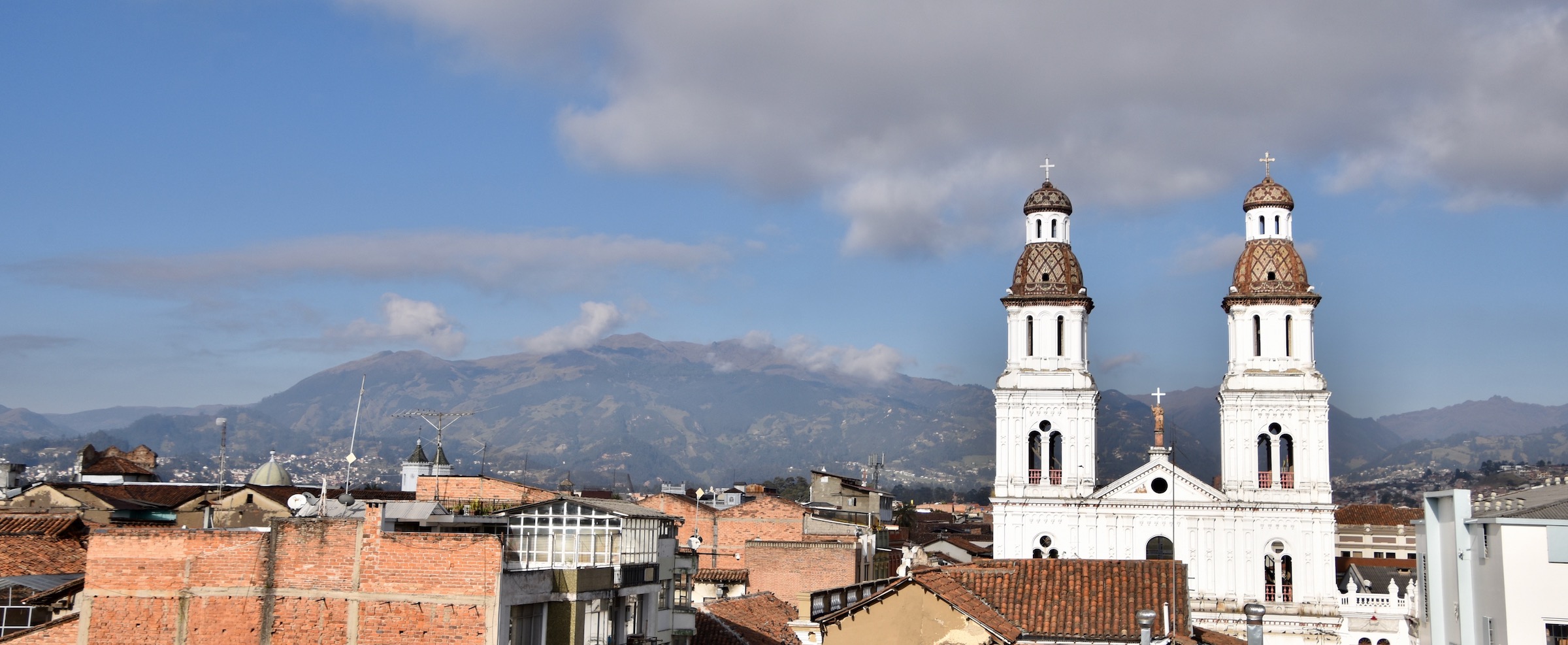
So we’ve got a great play to stay in Cuenca, now it’s time to explore the city.
Exploring Cuenca
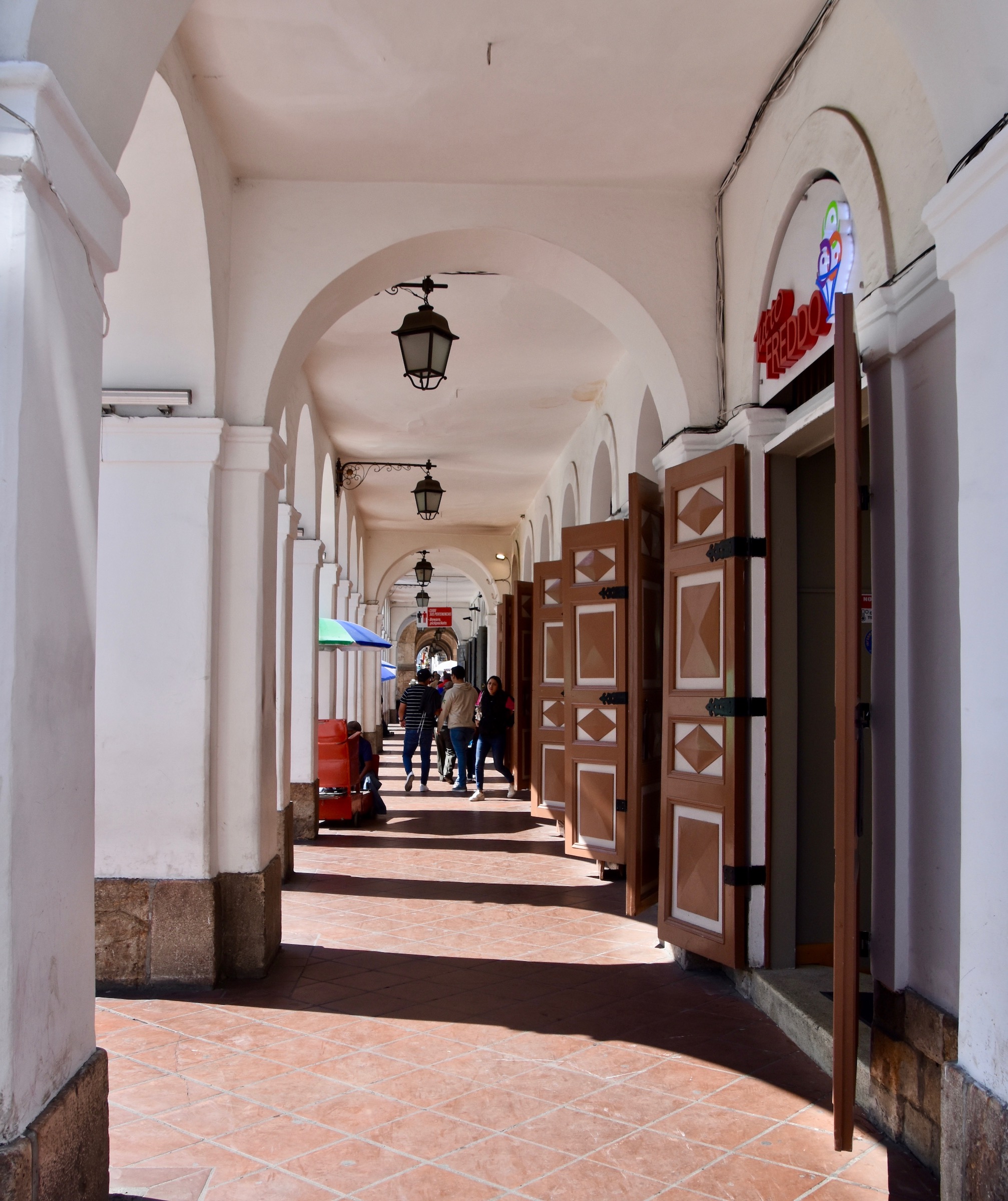
Not surprisingly given its proximity to the hotel the first place Wilson took us to was the plaza across from the cathedral that we had viewed from the roof the day before. Cuenca has a number of covered arcades that provide shade from the tropical sun.
This is the view from Calderon Plaza which we walked around before getting to the cathedral entrance.
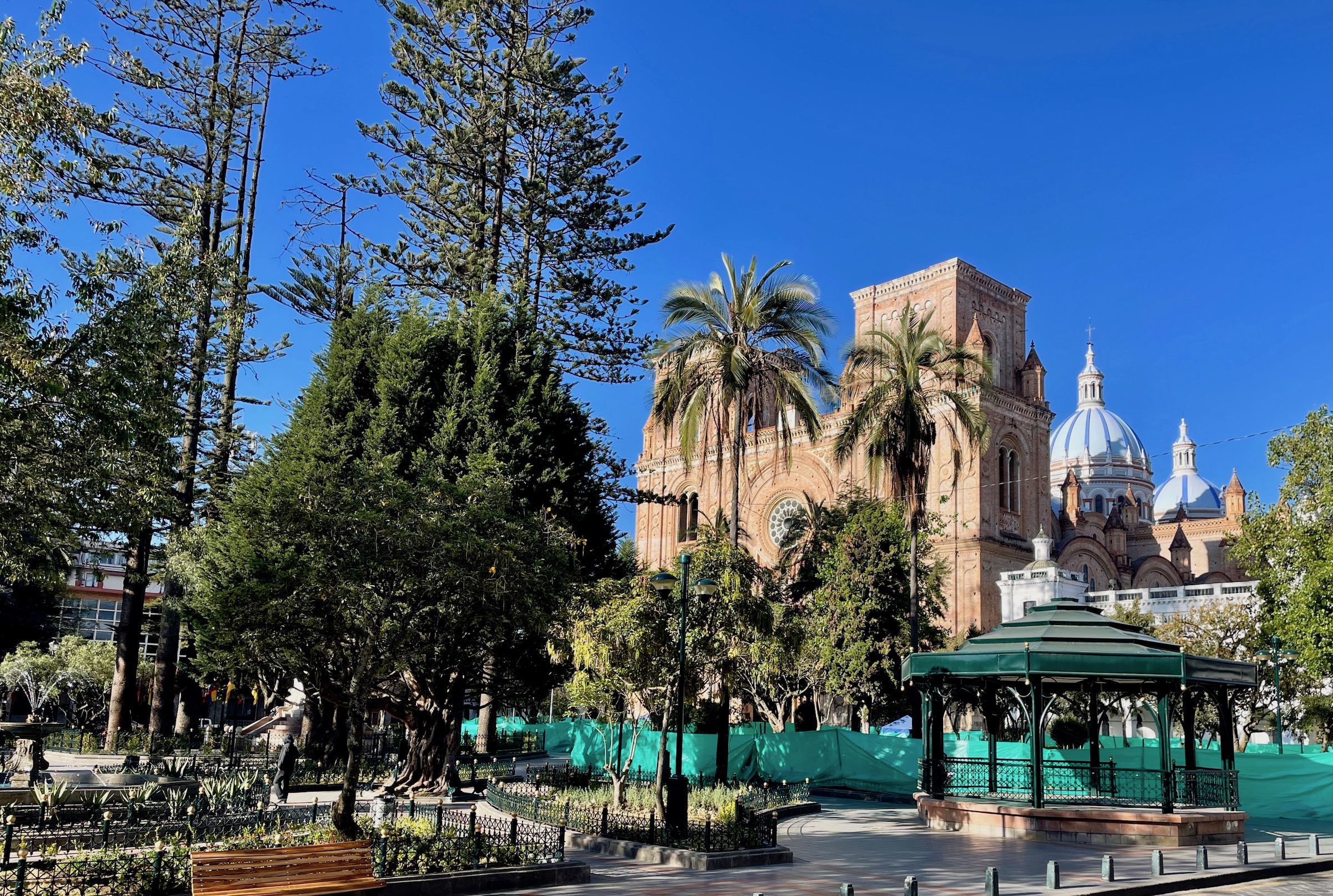
The plaza is named for Abdon Calderon,a native of Cuenca who was killed at the Battle of Pichincha outside of Quito in 1822 just short of his 18th birthday. His bravery in that battle was such that Simon Bolivar named Ecuador’s highest military honour after him. He is immortalized in this monument in the plaza.
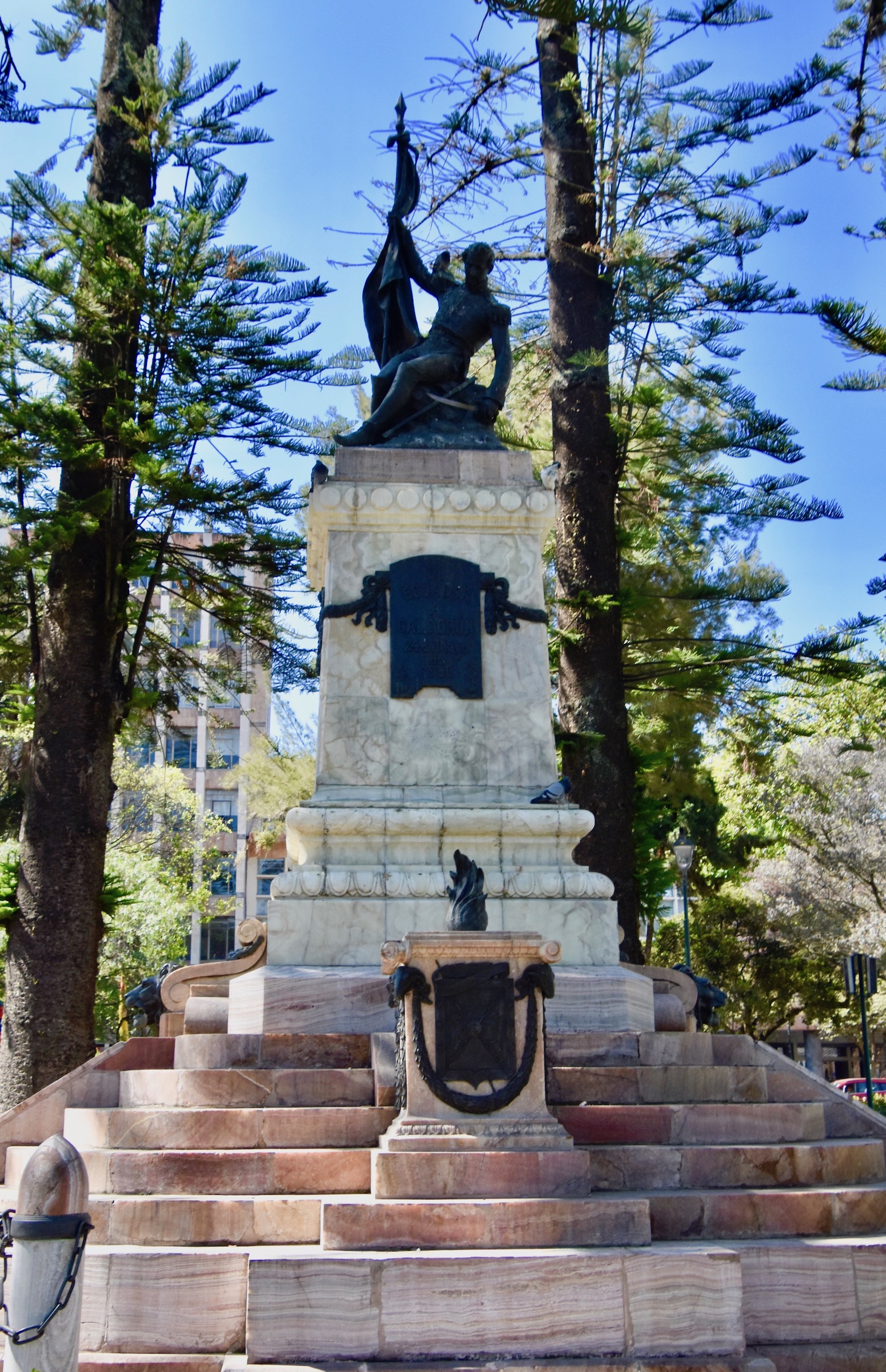
The plaza is also a place where parents can take their toddlers and youngsters for a chance to be a caballero with a choice of horse, pony or llama.
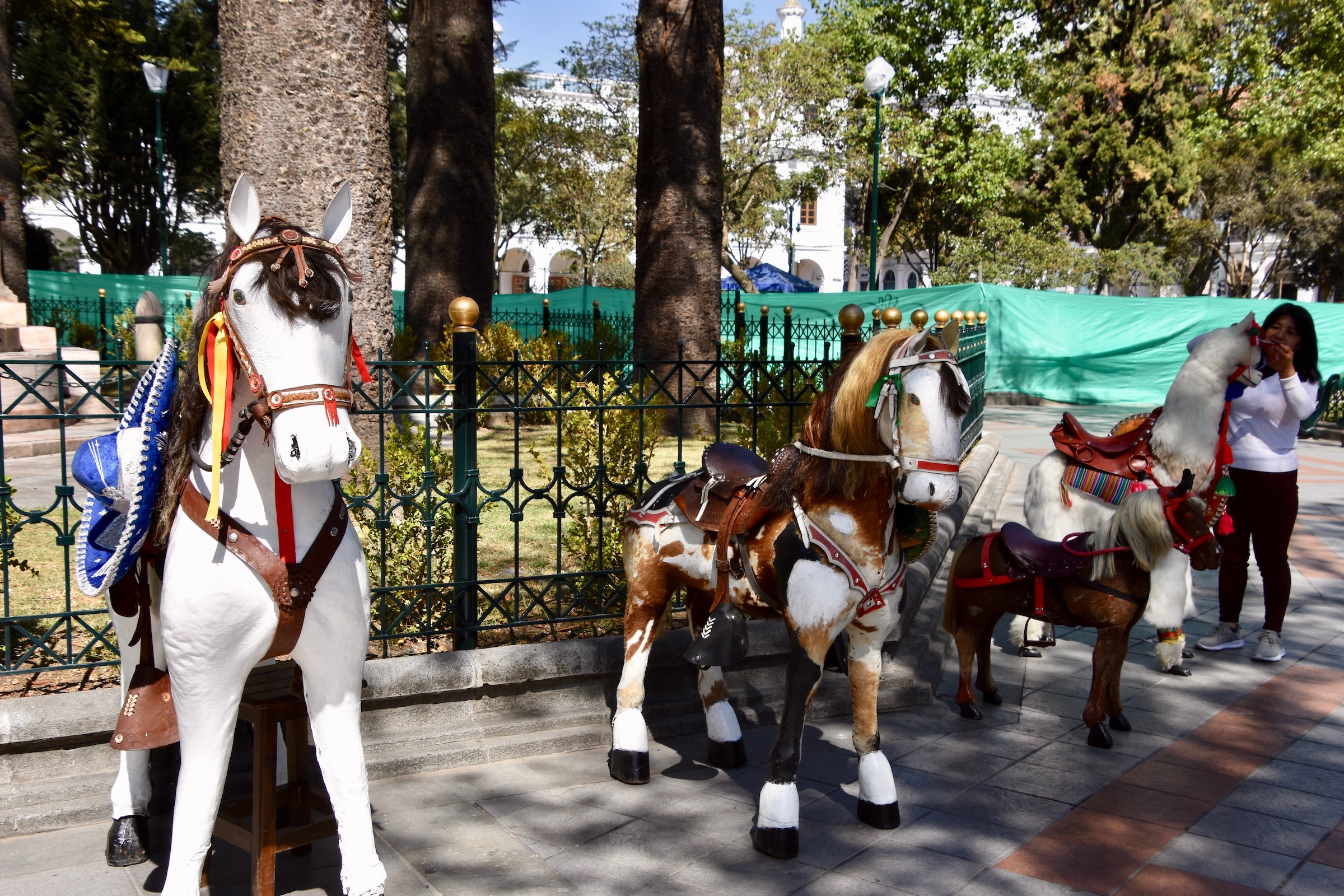
Cathedral of the Immaculate Conception
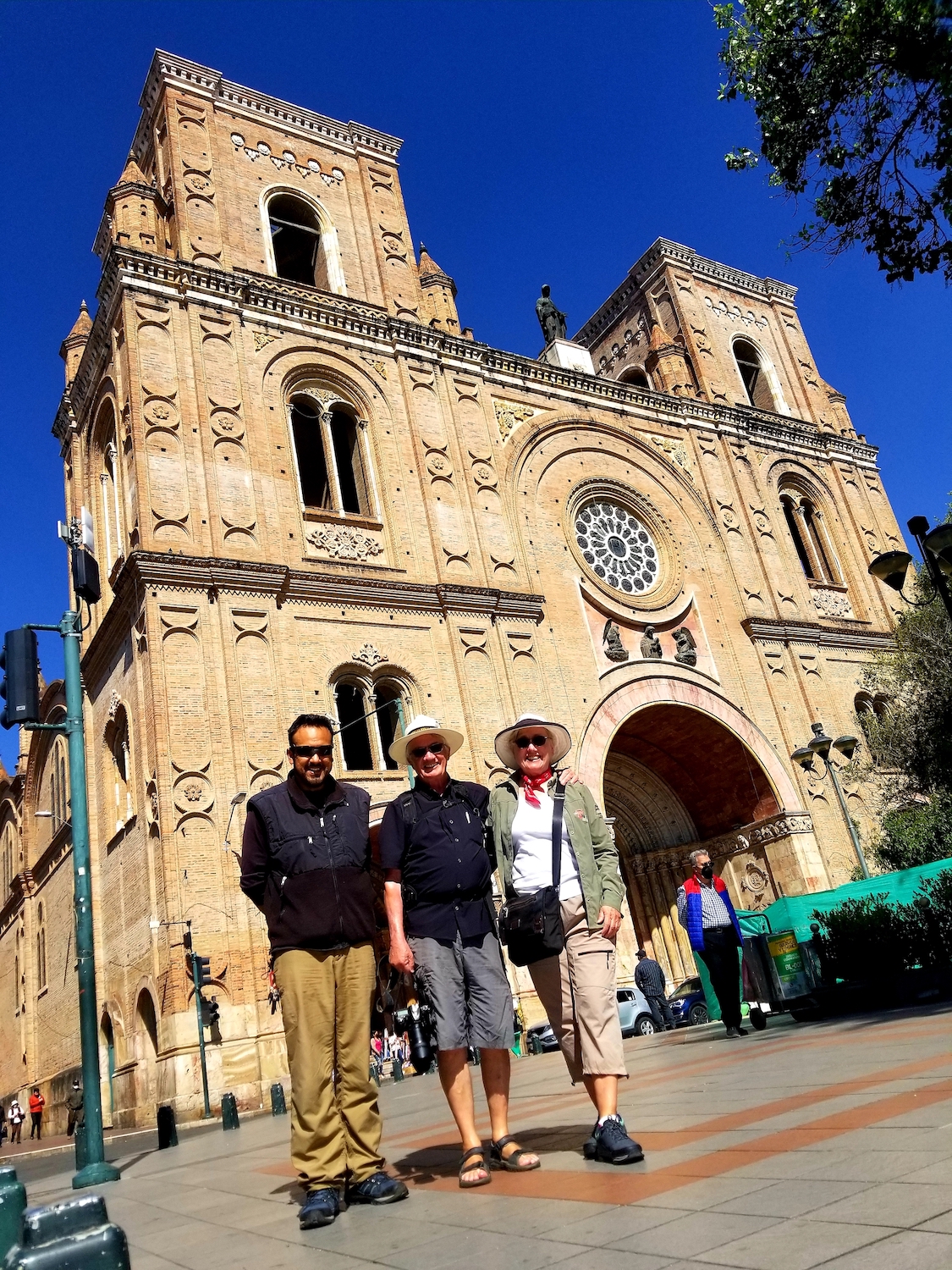
The number one tourist attraction in Cuenca is the Cathedral of the Immaculate Conception, aka the New Cathedral. This photo was taken by a policeman who got down to ground level to make sure he got the entire building in.
The three giant blue and white tile domes we observed from the roof the the Itza Hotel are now the most notable symbol of the city, but they are not really discernible from the front of the building which presents as neo-Gothic. The structure was started in 1855 and not finished for almost a century, unintentionally mimicking the time it took to build the original Gothic cathedrals.
Let’s go inside.
The stained glass is by Spanish born Guillermo Larrazabal who was specifically recruited to come to Cuenca from Spain to create the windows for the new cathedral. He liked the city so much that he moved here permanently.
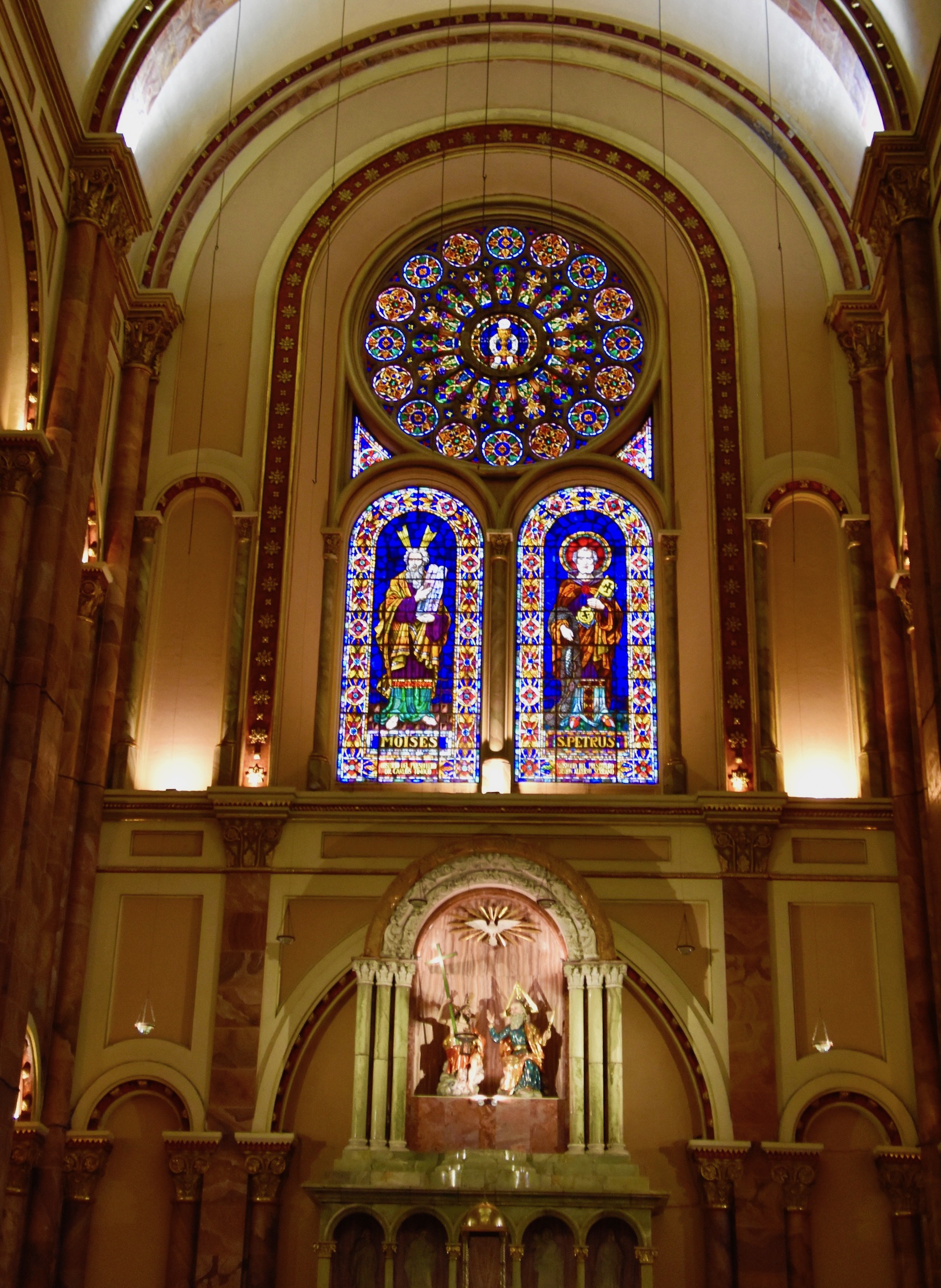
In 1985 Pope Jean Paul II paid a visit to Cuenca, celebrating a mass in Miraflores Park. That event is commemorated with this statue of him in the new cathedral.
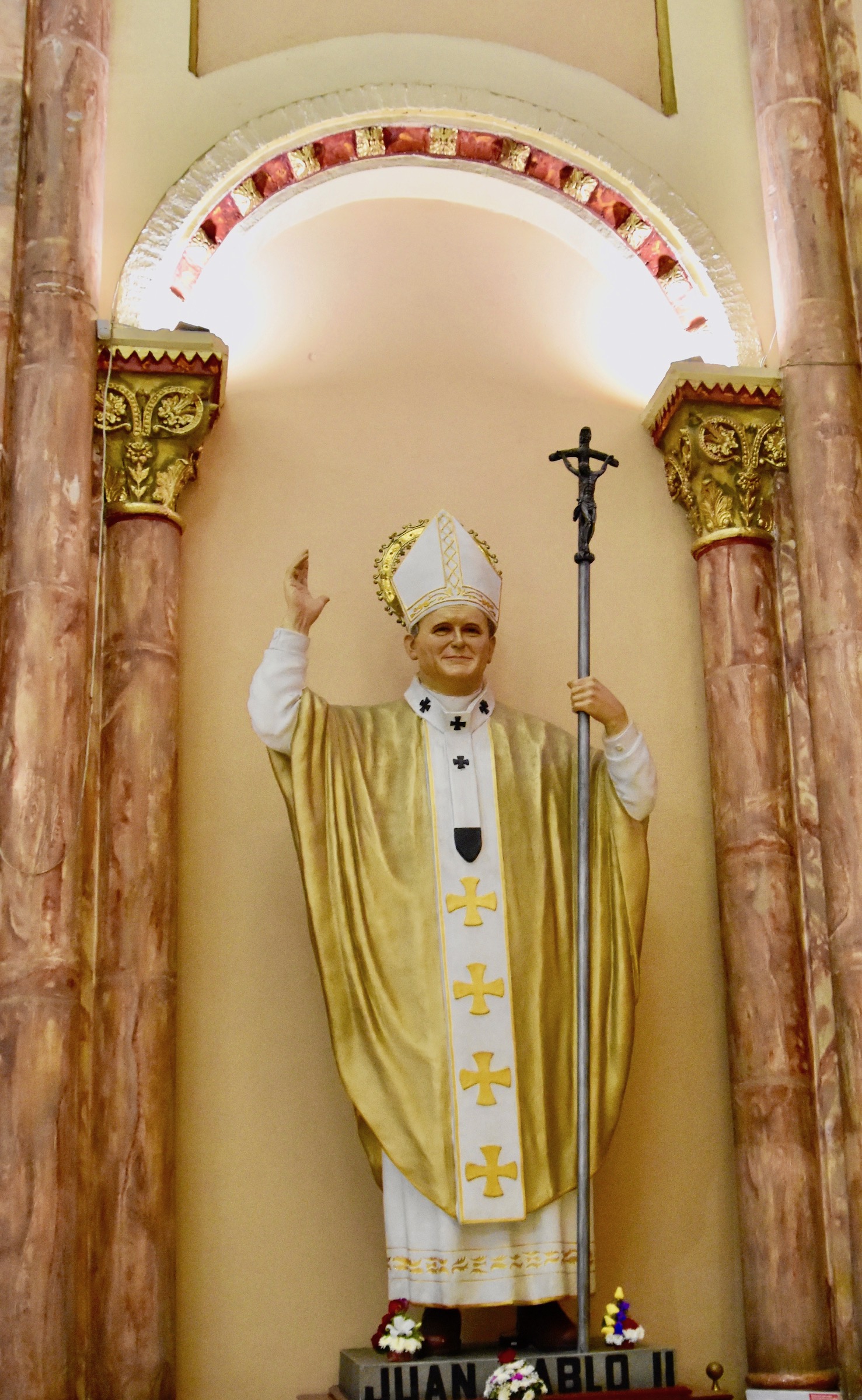
This is the altar and as impressive as it is, it cannot compare with the interior of La Compania in Quito which we saw at the beginning of this trip.
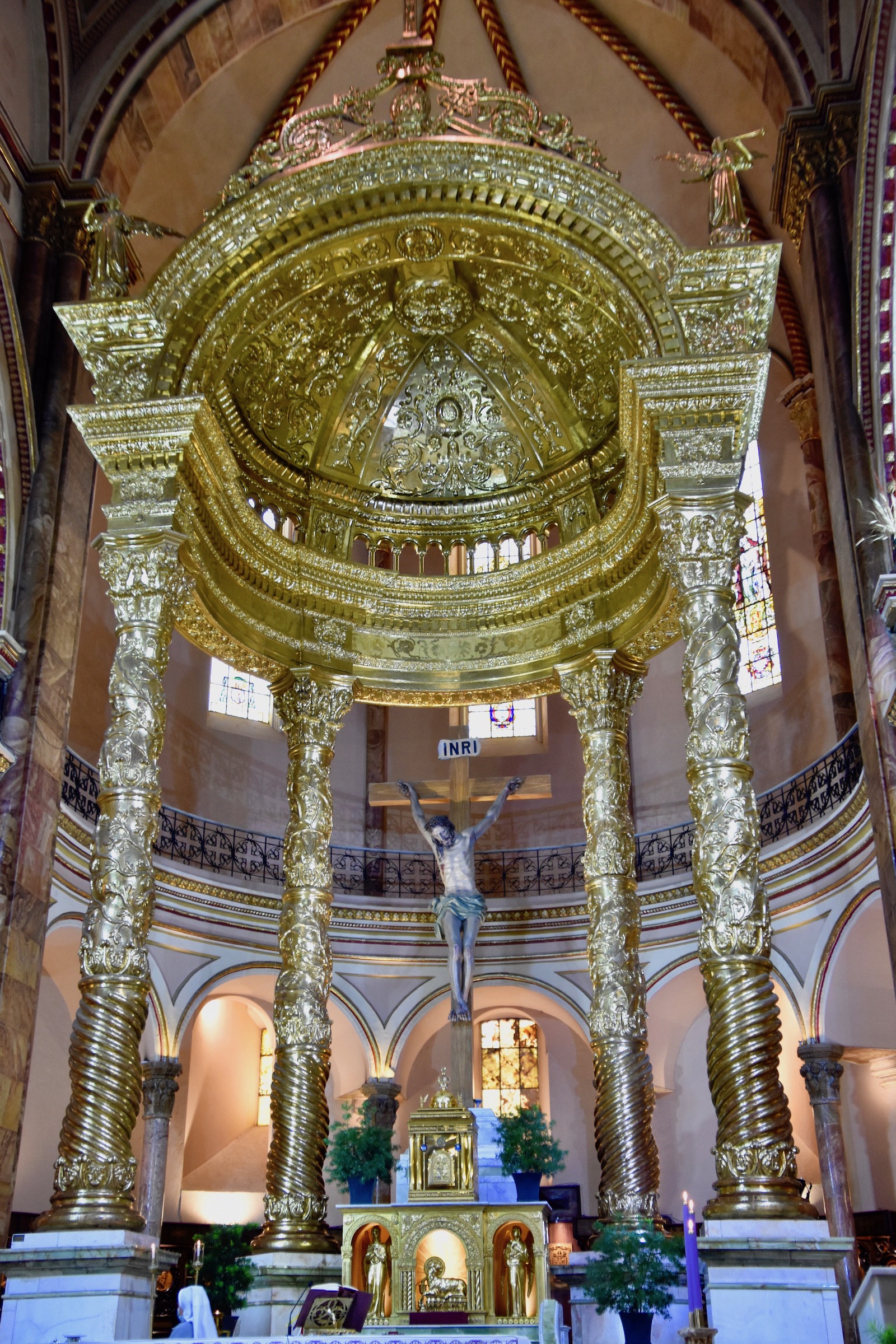
After a quick tour of the interior Wilson leads us up to the roof where he took this picture of us on what was turning into a gorgeous day in Cuenca.
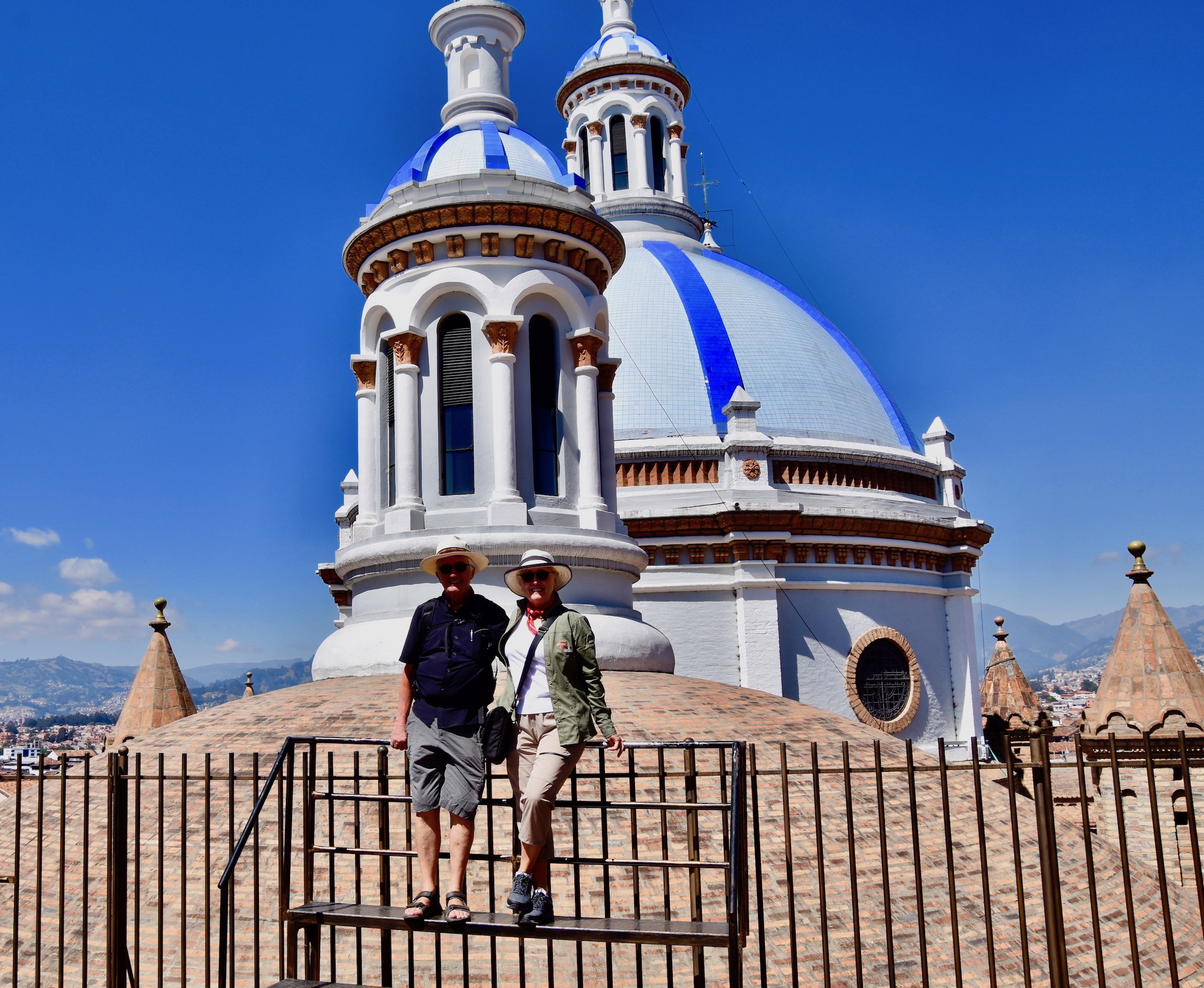
Back at ground level we next headed on foot to the city market passing through this flower market on the way.
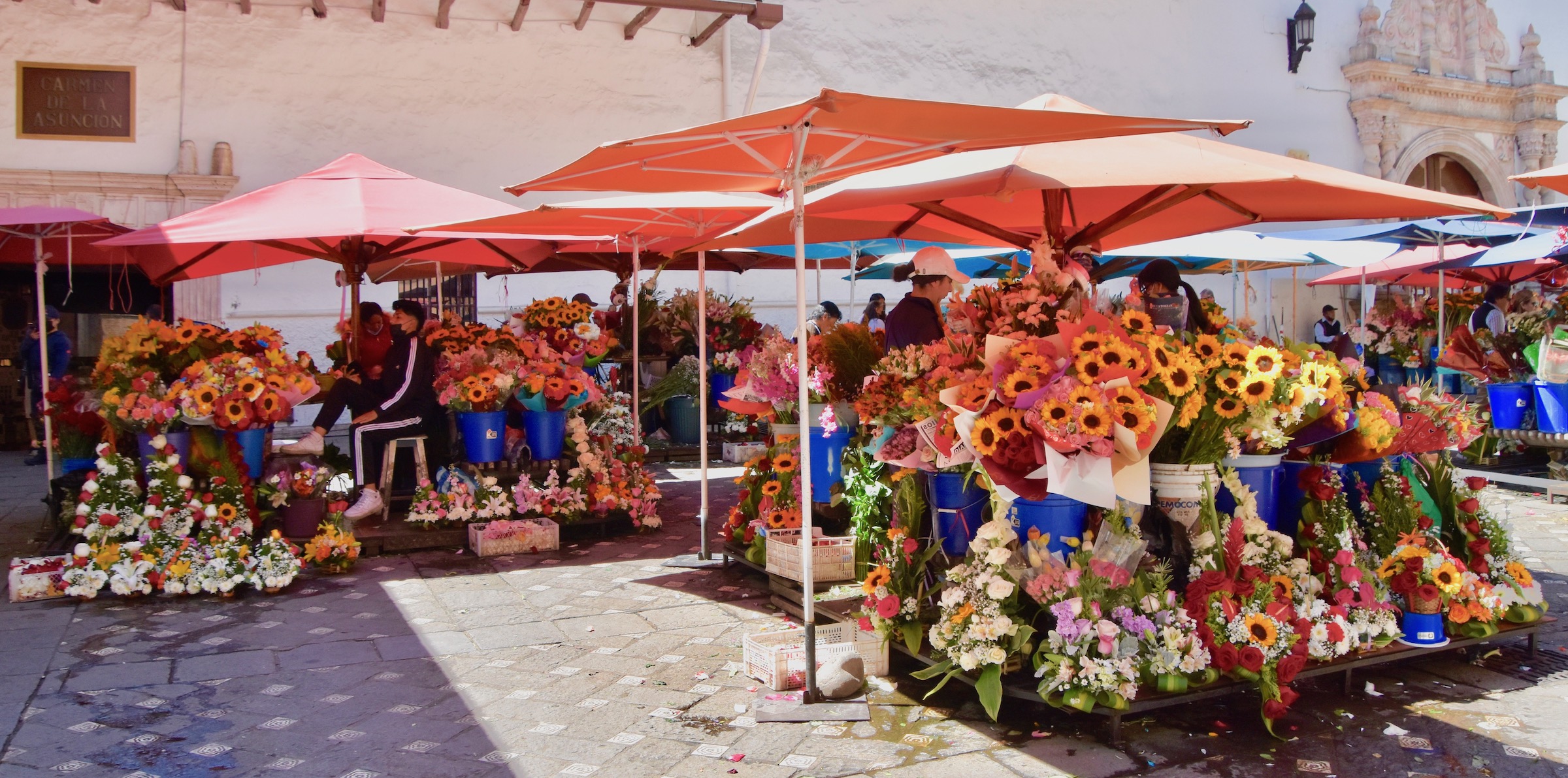
Mercado 10 de Augusto
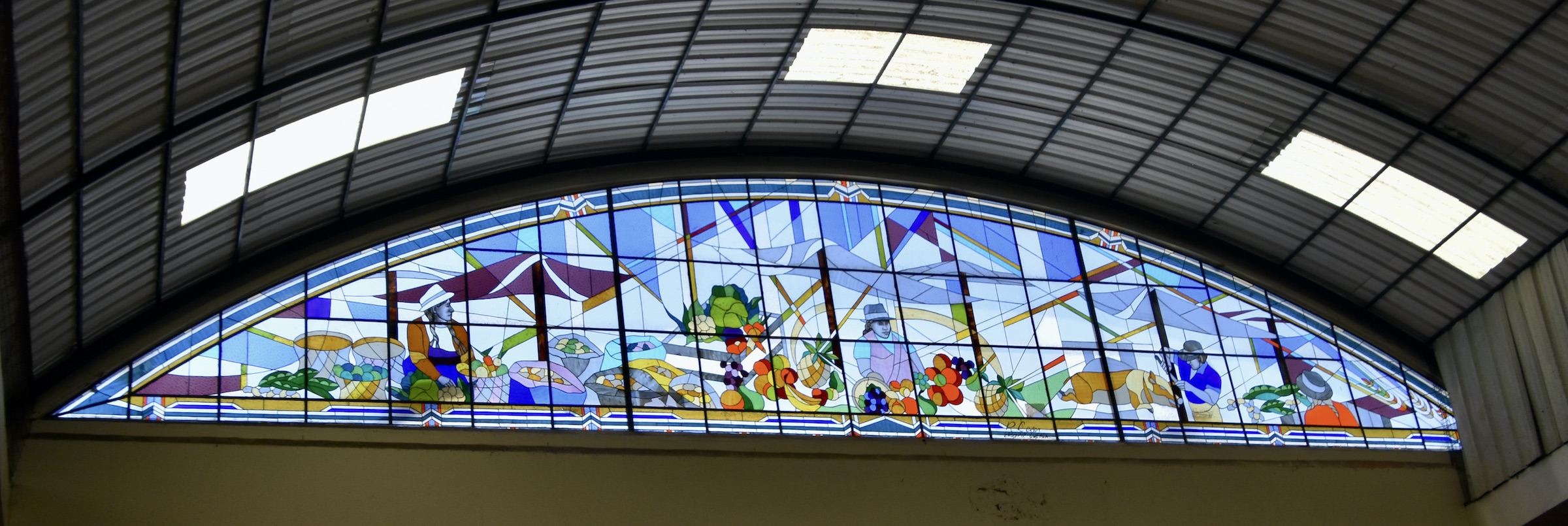
This market, named for Ecuador’s independence day in the heart of the historic city, is a genuine market whose customers are locals and not tourists. It’s in a large two story building with several really nice stained glass murals.
Like most Latin American markets it’s divided into sections with all the meat, fruit and vegetable sellers located next to each other. While in North America one might find maybe six or seven varieties of potatoes at most, in Cuenca this lady had well over twenty distinct varieties on offer.
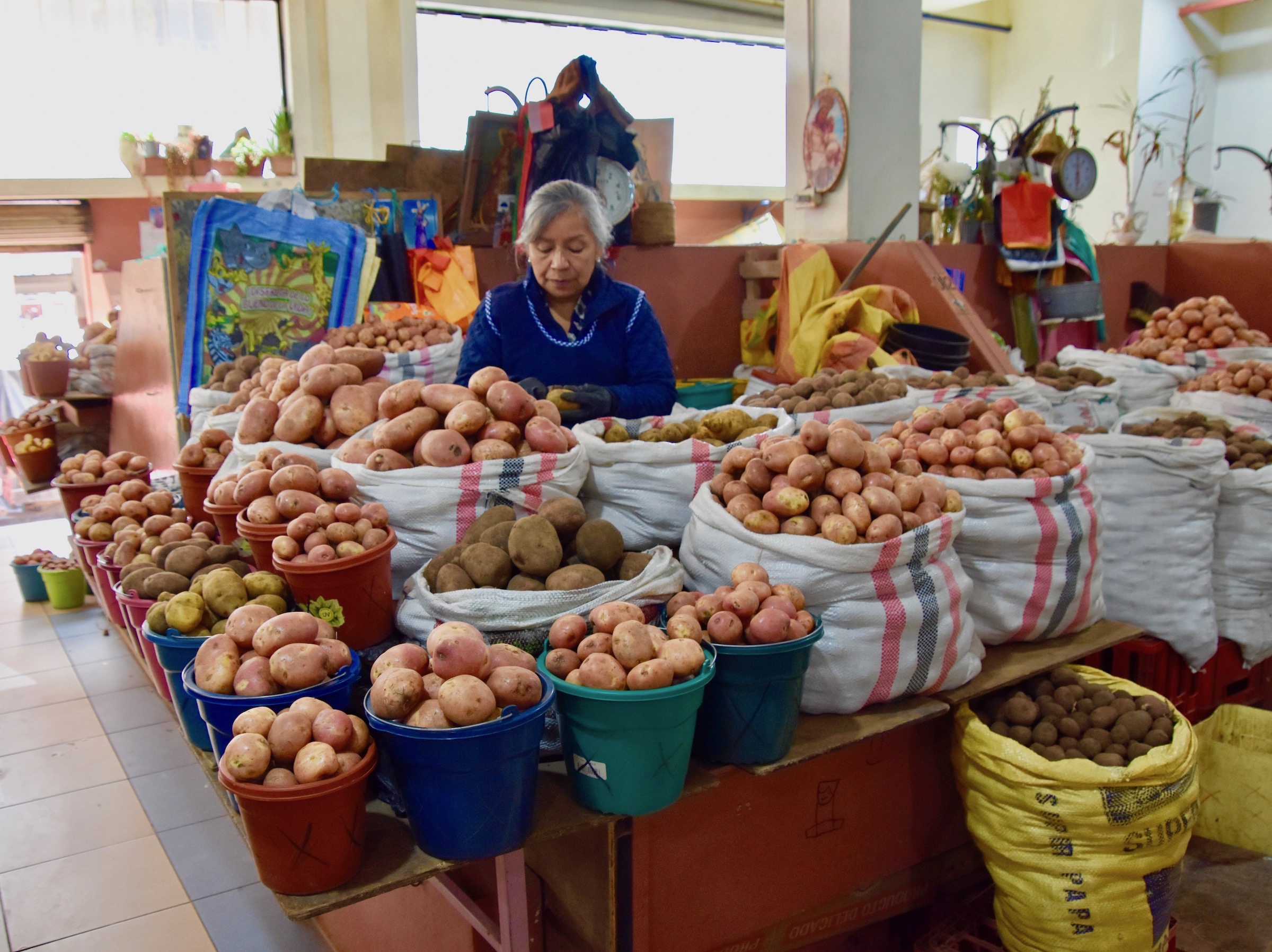
Likewise with varieties of dried beans.
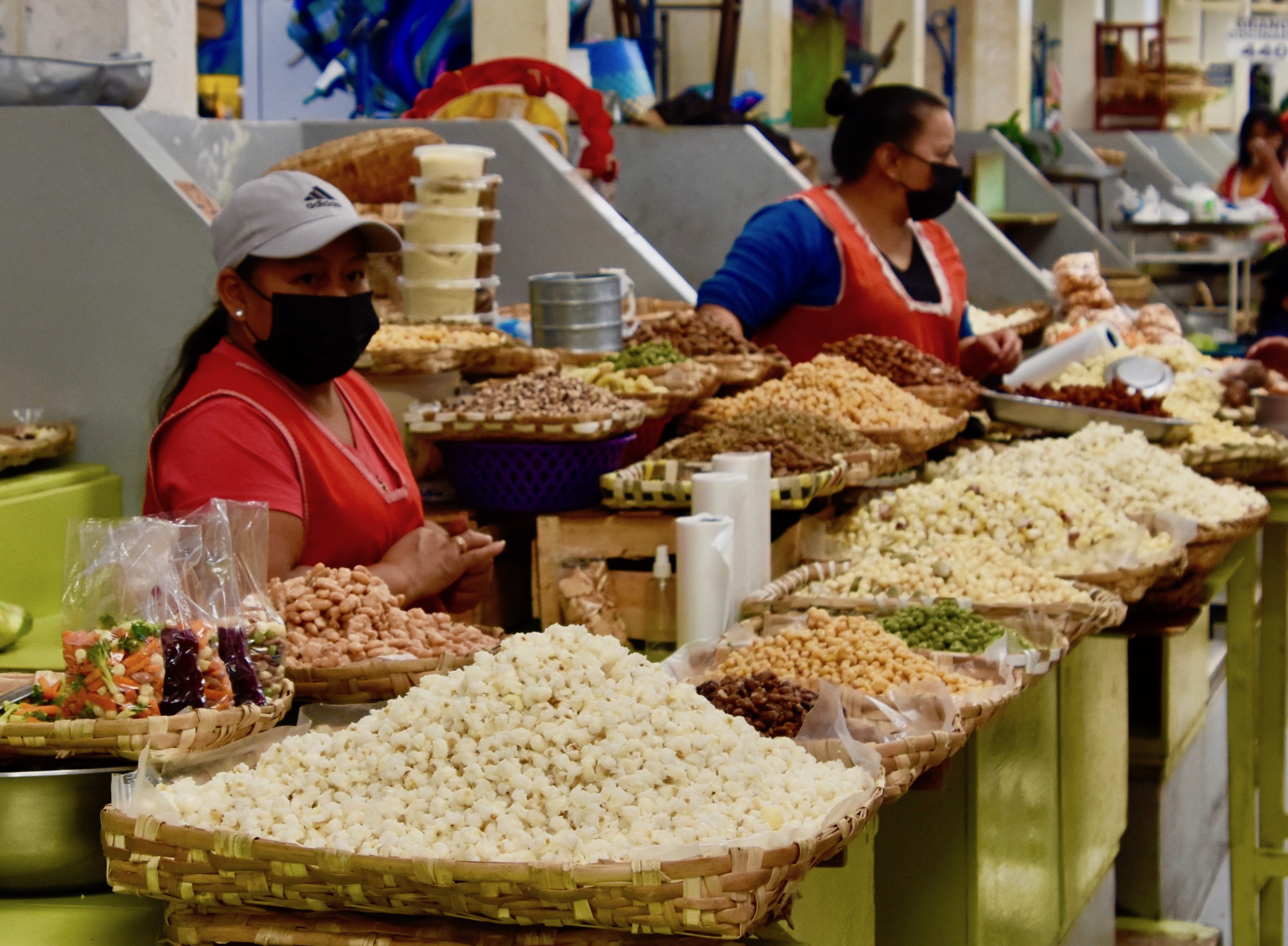
Markets like this are popular with photographers for a good reason. Colourful doesn’t begin to describe the goods on display.
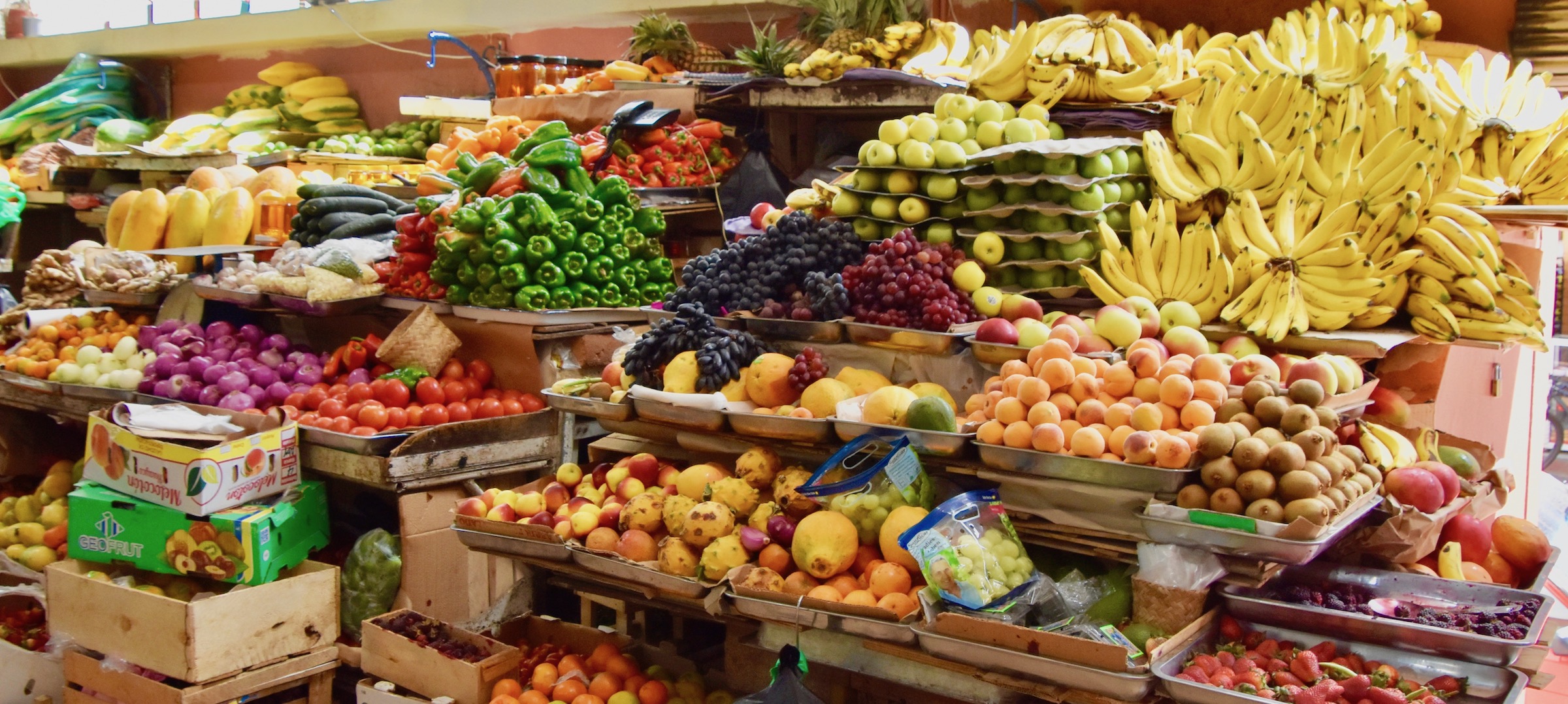
One reason you know it’s not a tourist market is the prices. These bags of tomatoes, oranges, apples etc. were each $1USD a bag.
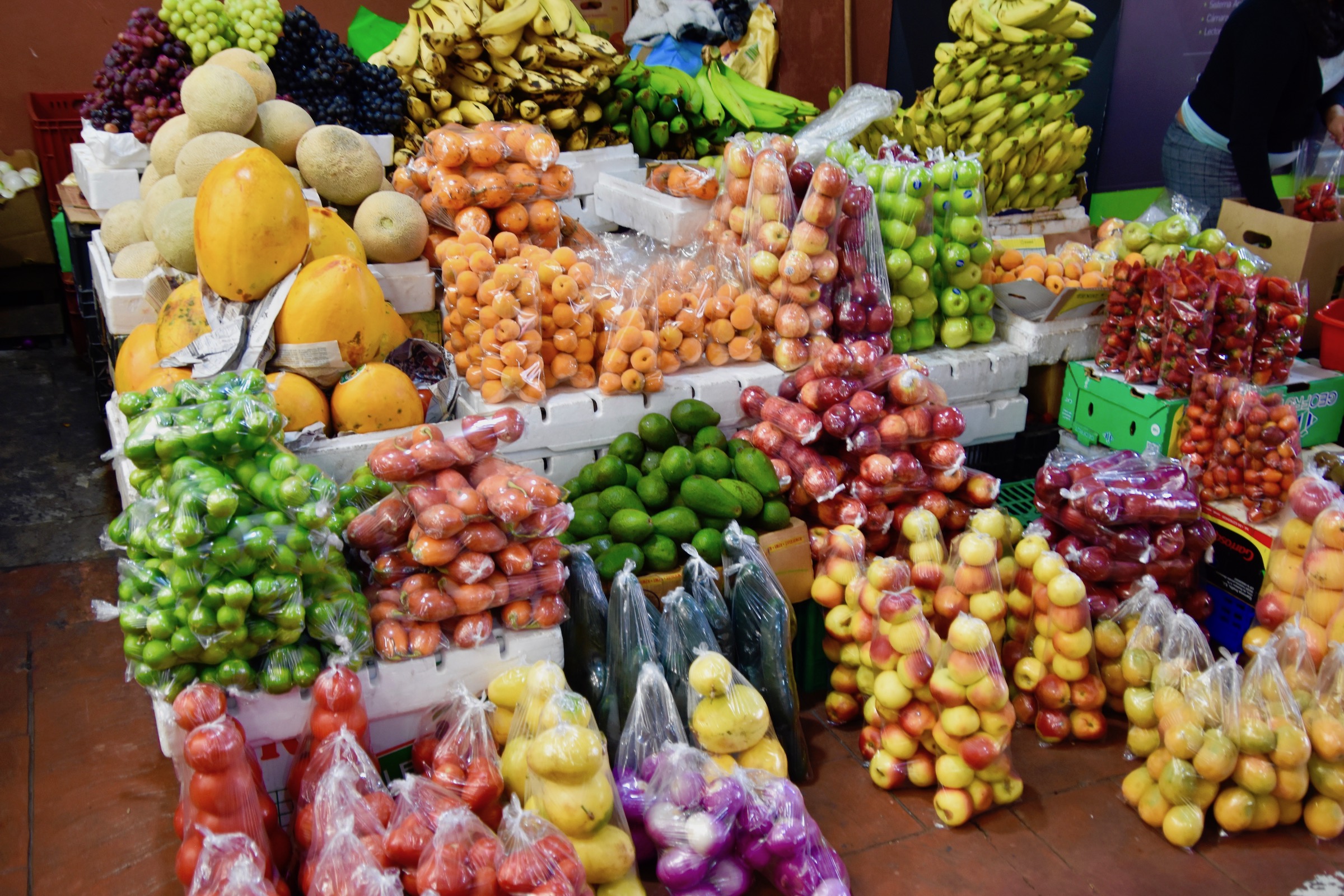
However, Wilson had an ulterior motive in taking us to the market – we had to try one of Cuenca’s famed delicacies, hornados. These are slow cooked whole pigs and on the second floor of the market there were at least a dozen booths offering them.
Wilson went up to what he described was his favourite hornados vendor and made the purchase.
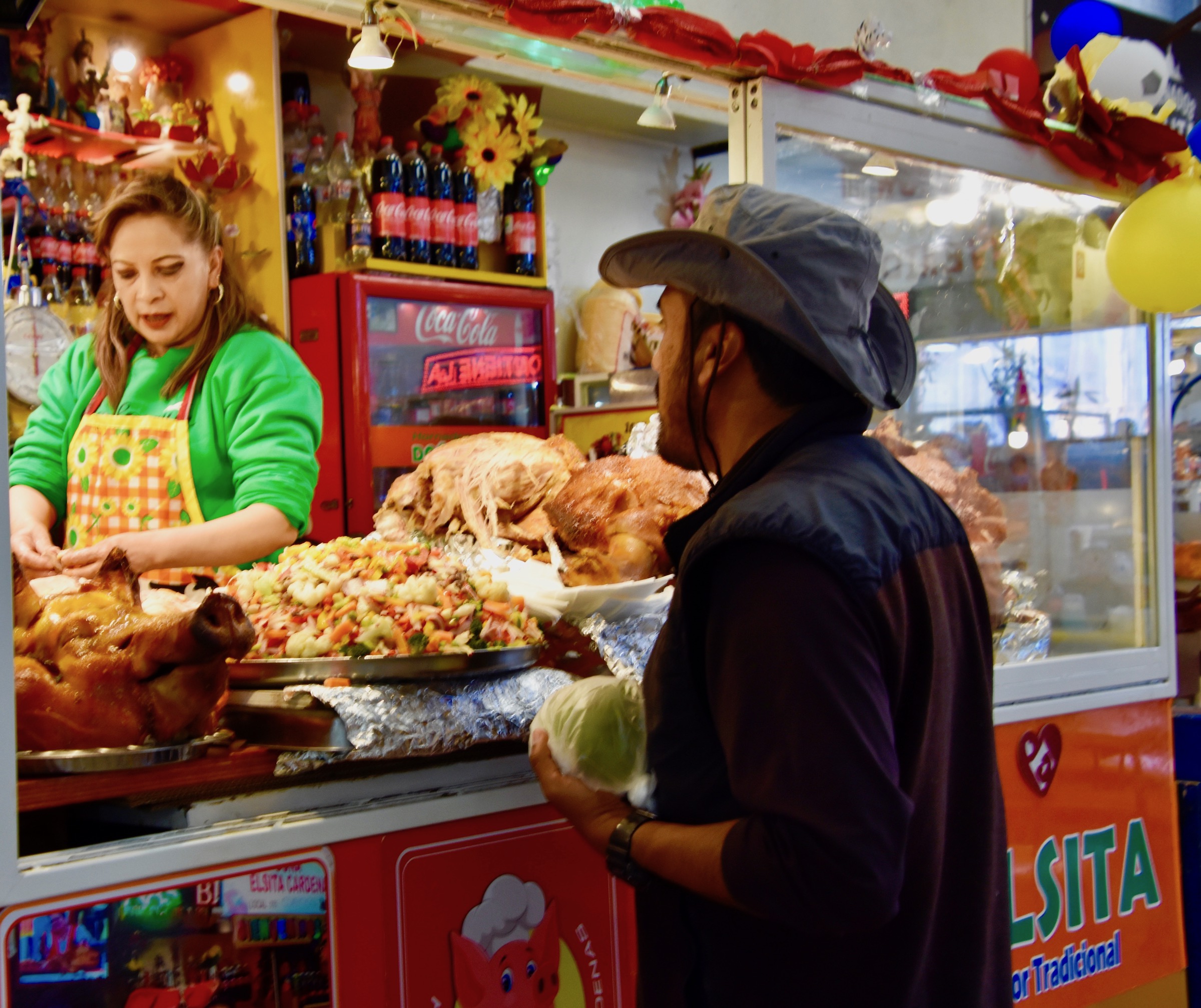
I have to say that roast pork is one of my go to meats and the hornados were off the chart in crispy fat laden goodness. My mouth waters just thinking back on it. Wilson asked us not to gorge ourselves on the hornados as much as I was tempted to because he had another Cuenca specialty he wanted us to try later in the day.
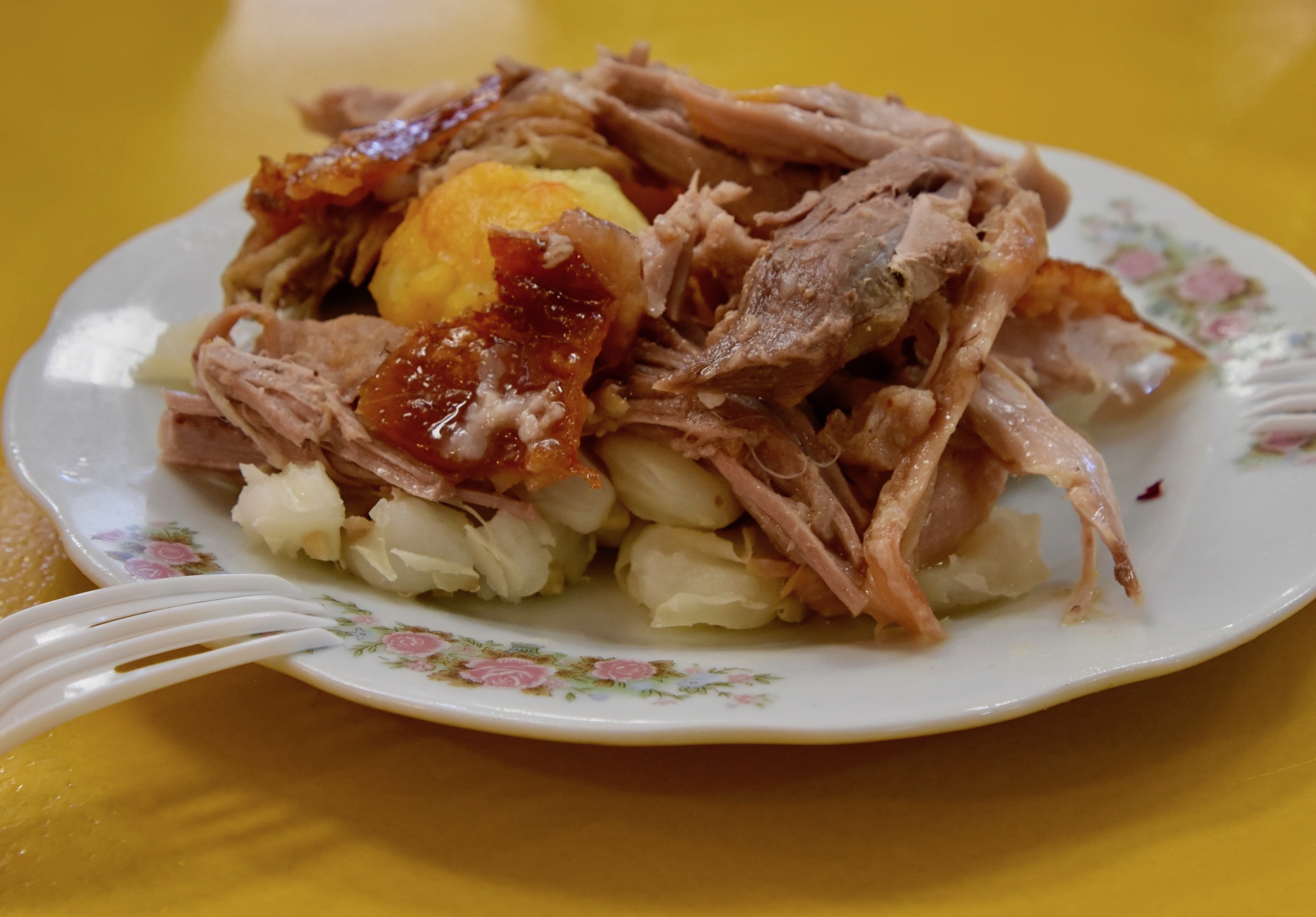
From the market we continued our exploration of Cuenca by going to another place of business for which the city is famous, a Panama hat factory.
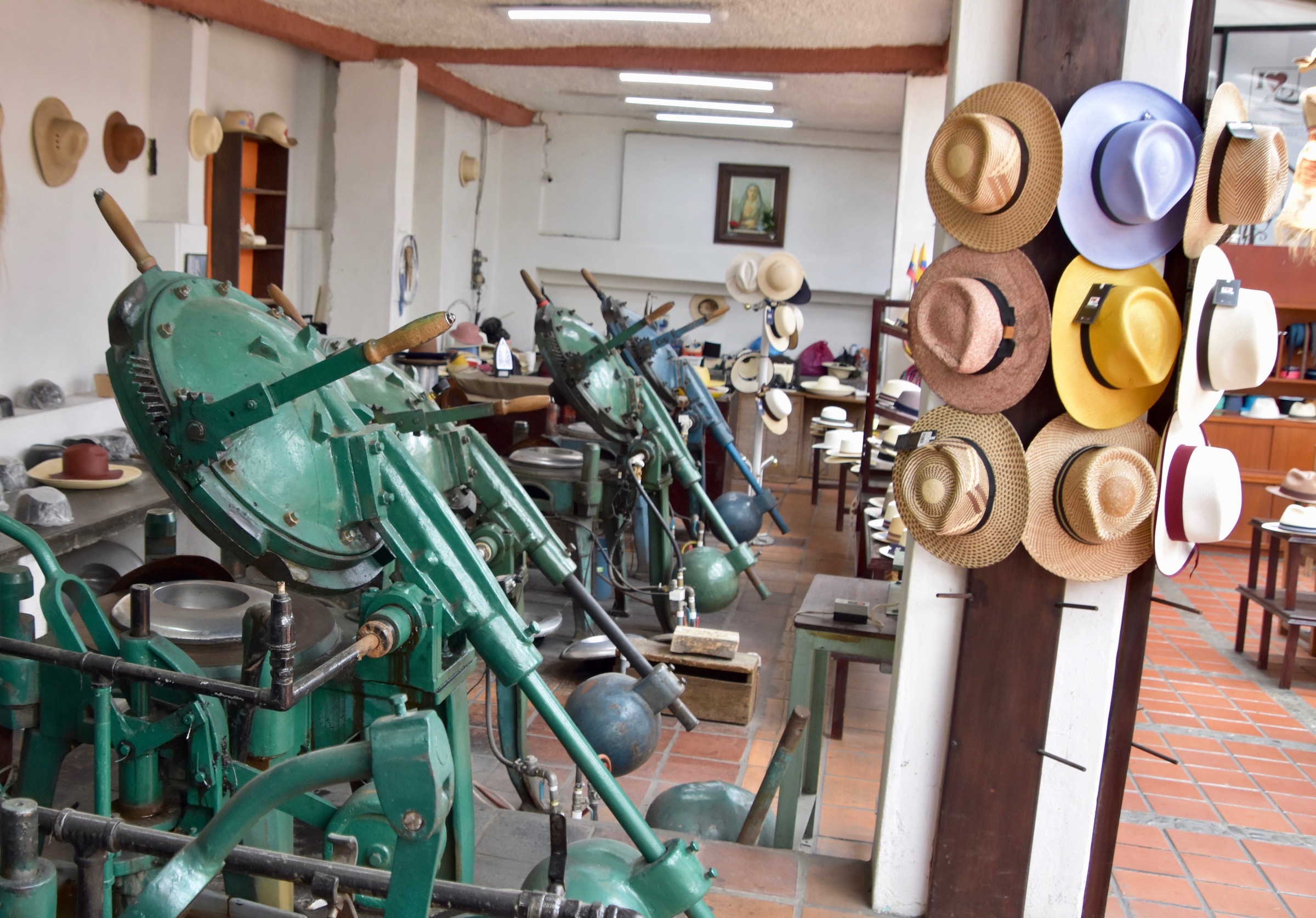
Most people mistakenly believe that Panama hats are made in Panama. They aren’t, but rather originated in the small town of Montecristi, Ecuador and that name is still associated with the finest of Panama hats that can easily exceed $1,000 USD. However, Cuenca also makes the hats in a number of factories and we were given a short presentation of how the hats are made. The photo above shows the presses that create the unique shape of the hats that were the trademark of Frank Sinatra who wore them more than the fedoras he is usually associated with. We also had an opportunity to buy genuine Panama hats in every size and colour one could want. However, I had already purchased mine a few weeks earlier in the market at Otavalo market north of Quito so we came away empty handed. BTW Wilson took us here to see how the hats were made and not on a selling mission which I appreciated.
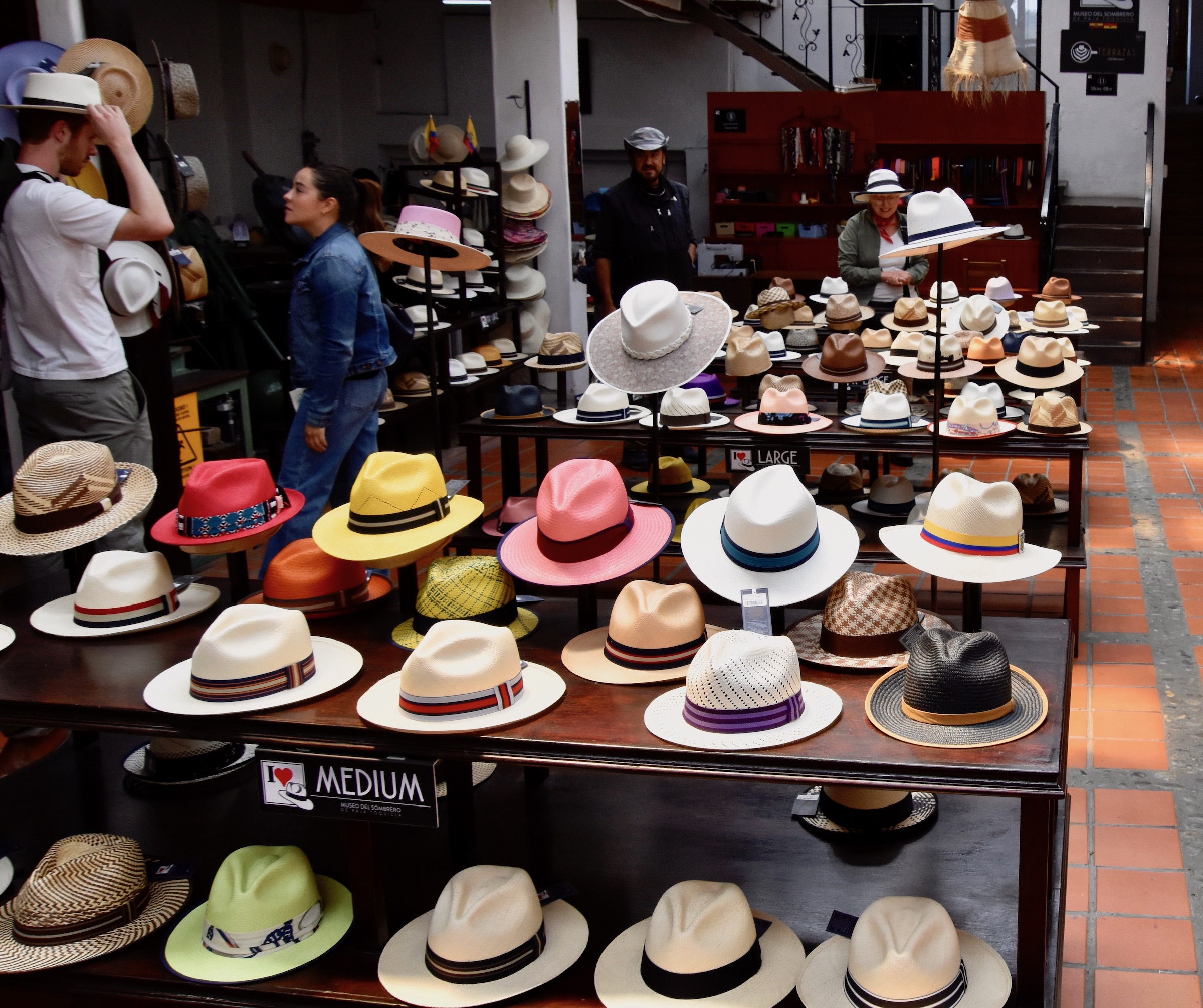
For our next stop we needed to take the vehicle as we headed to the highest point in the city to the mirador that provides this fantastic view of the city.
Once you leave the historic centre of Cuenca you discover a very modern and prosperous city that is clean, safe (not that the centre is not safe) and inviting. I could see why Cuenca is becoming a popular retirement spot for North Americans and Europeans.
Our final stop on this post will be to local restaurant where we will try cuy, the other traditional food of Cuenca. You might know cuy more by its Anglicized name, Guinea pig. However, cuy is neither a pig or from Africa. It is an animal that has been domesticated for thousands of years as a source of animal protein.
The cuy are cooked on a spit like below and served in open air restaurants. We were the only tourists in the one Wilson took ust to.
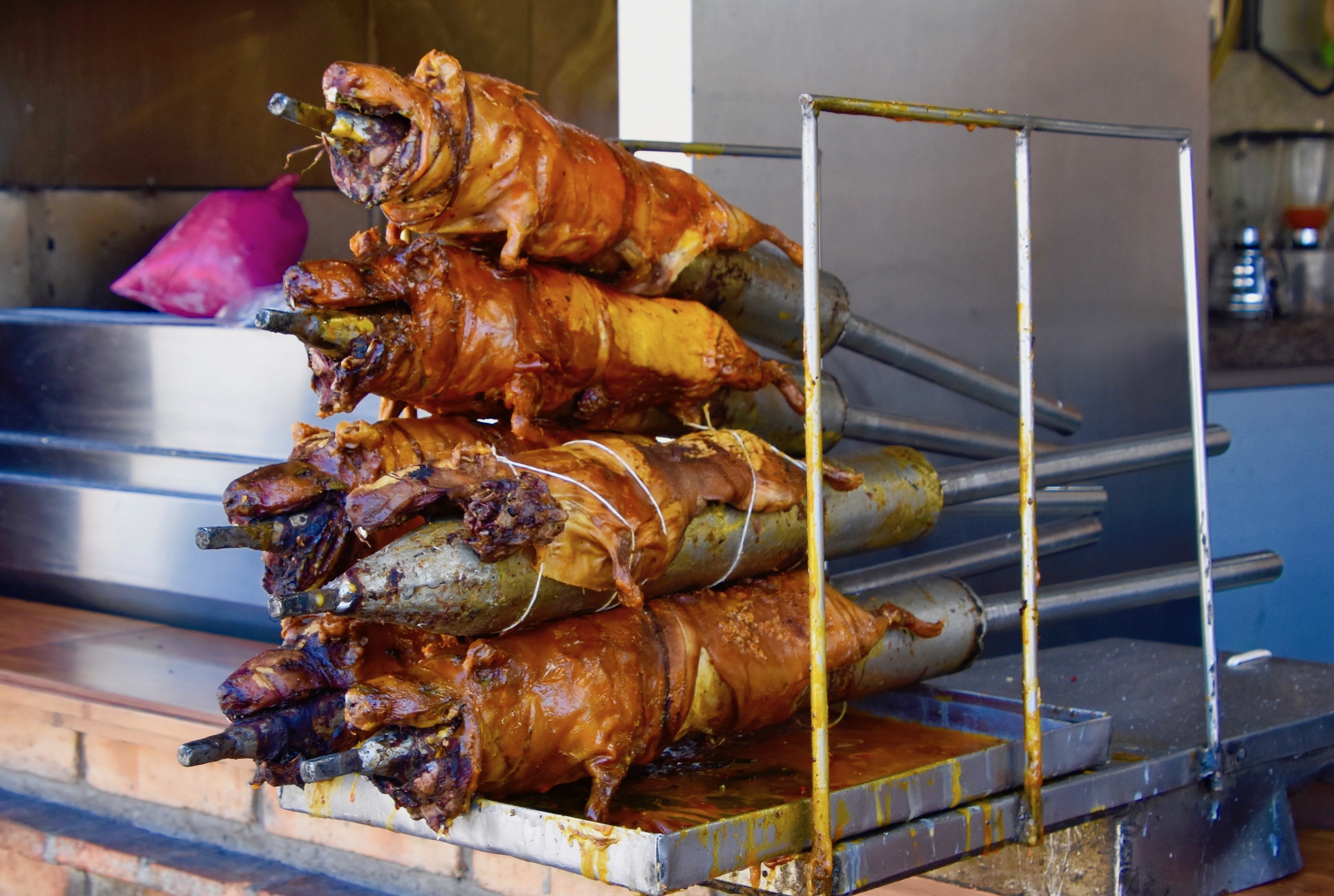
Here is what a meal of cuy looks like, served with potatoes, corn and hot sauce. Not surprisingly given that it is a rodent, the meat tastes a lot like rabbit, but to my mind better. Definitely every carnivore visitor to Cuenca should try this dish, but if there is a choice between hornados and cuy, go for the hornados.
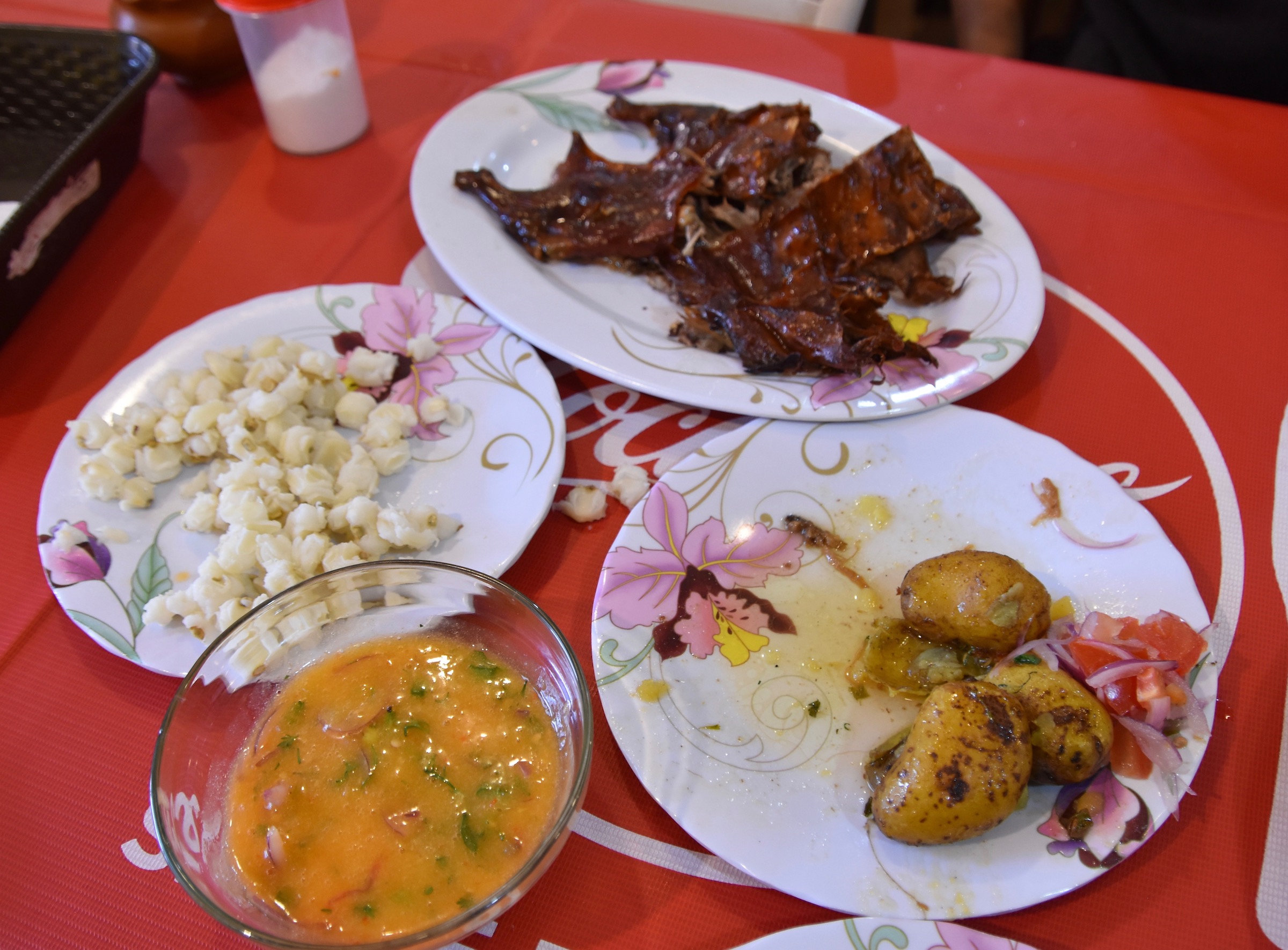
Well, we’ve finally come to the end of our amazing journey through this South American country that has so much variety. I’ll sign off from the lobby of the Itza Hotel where Wilson took this picture of us in December, 2022.
